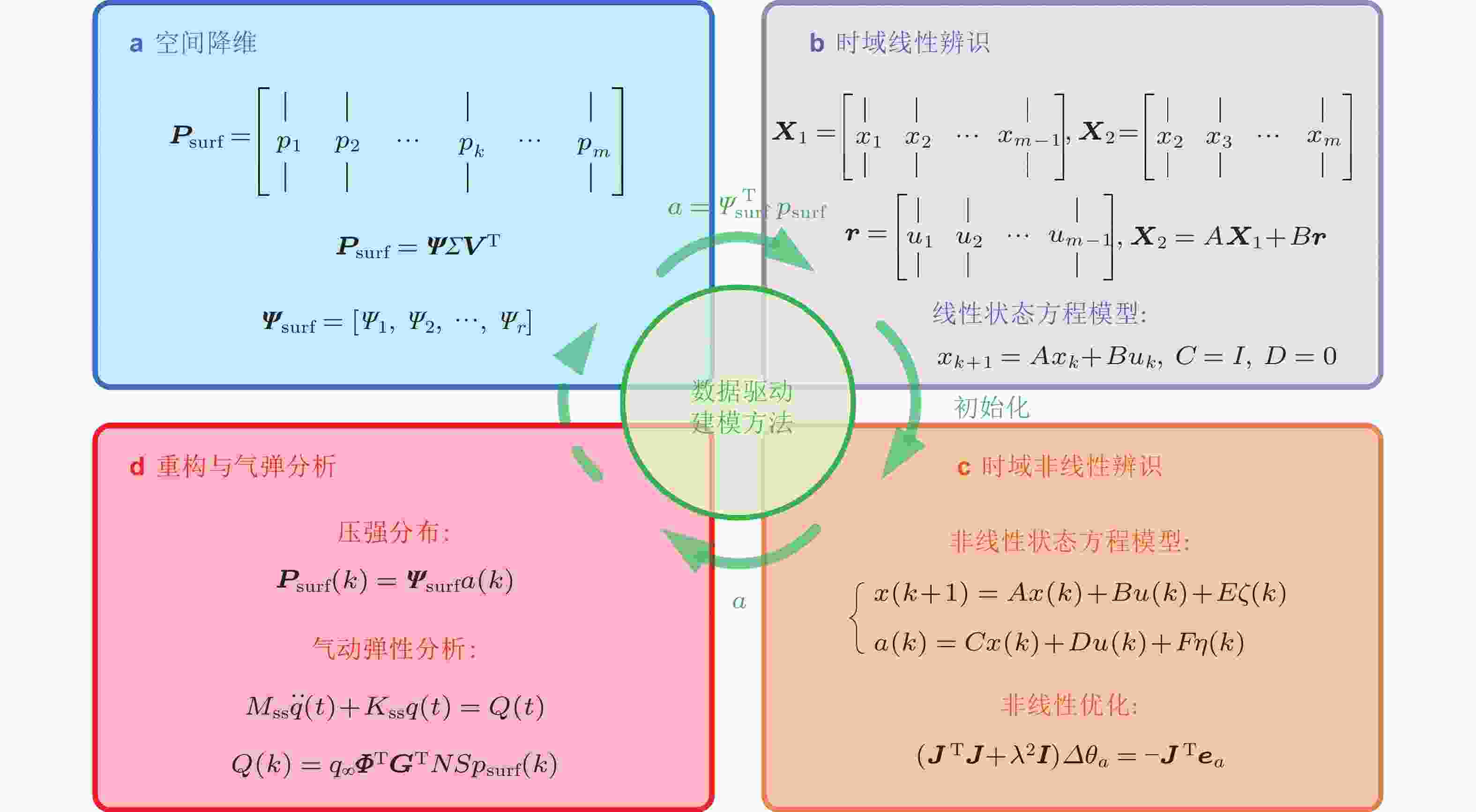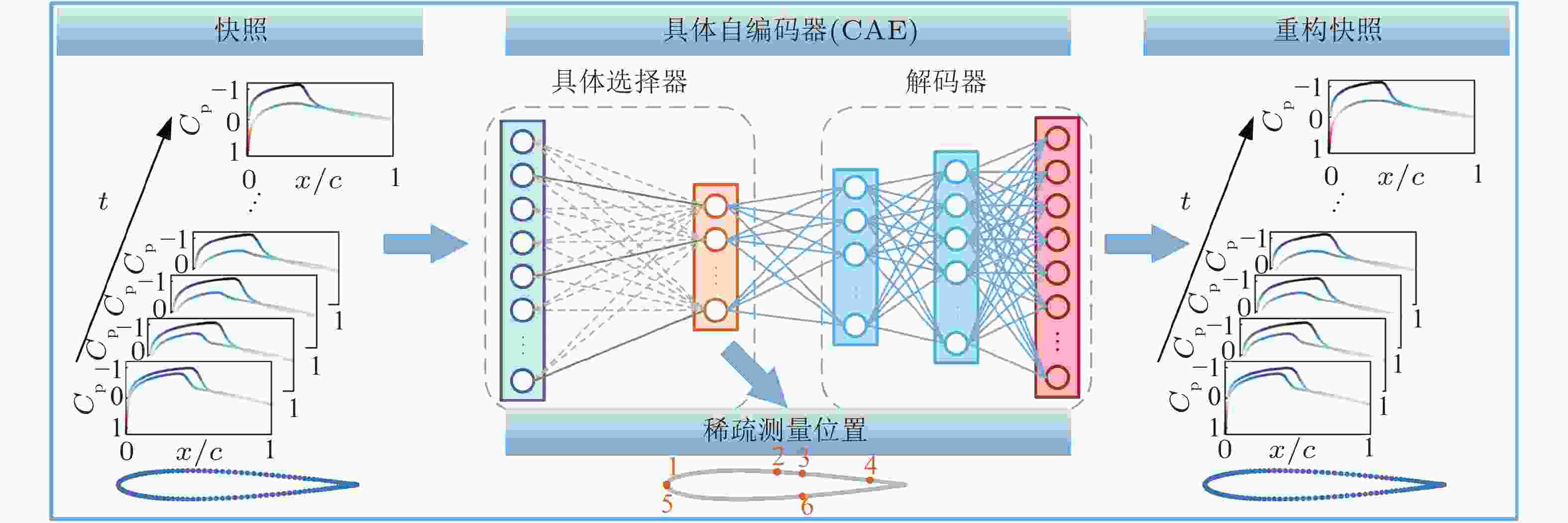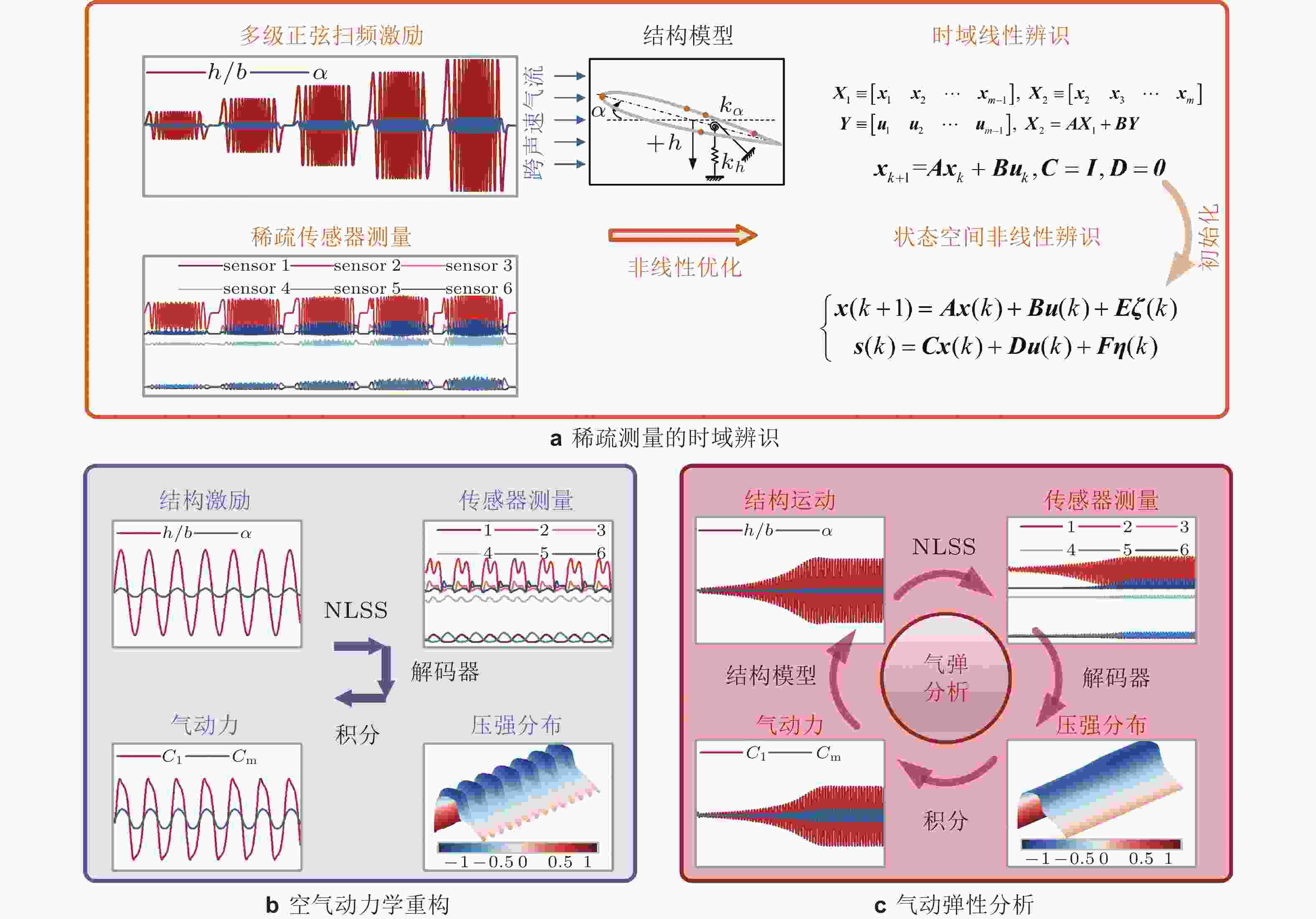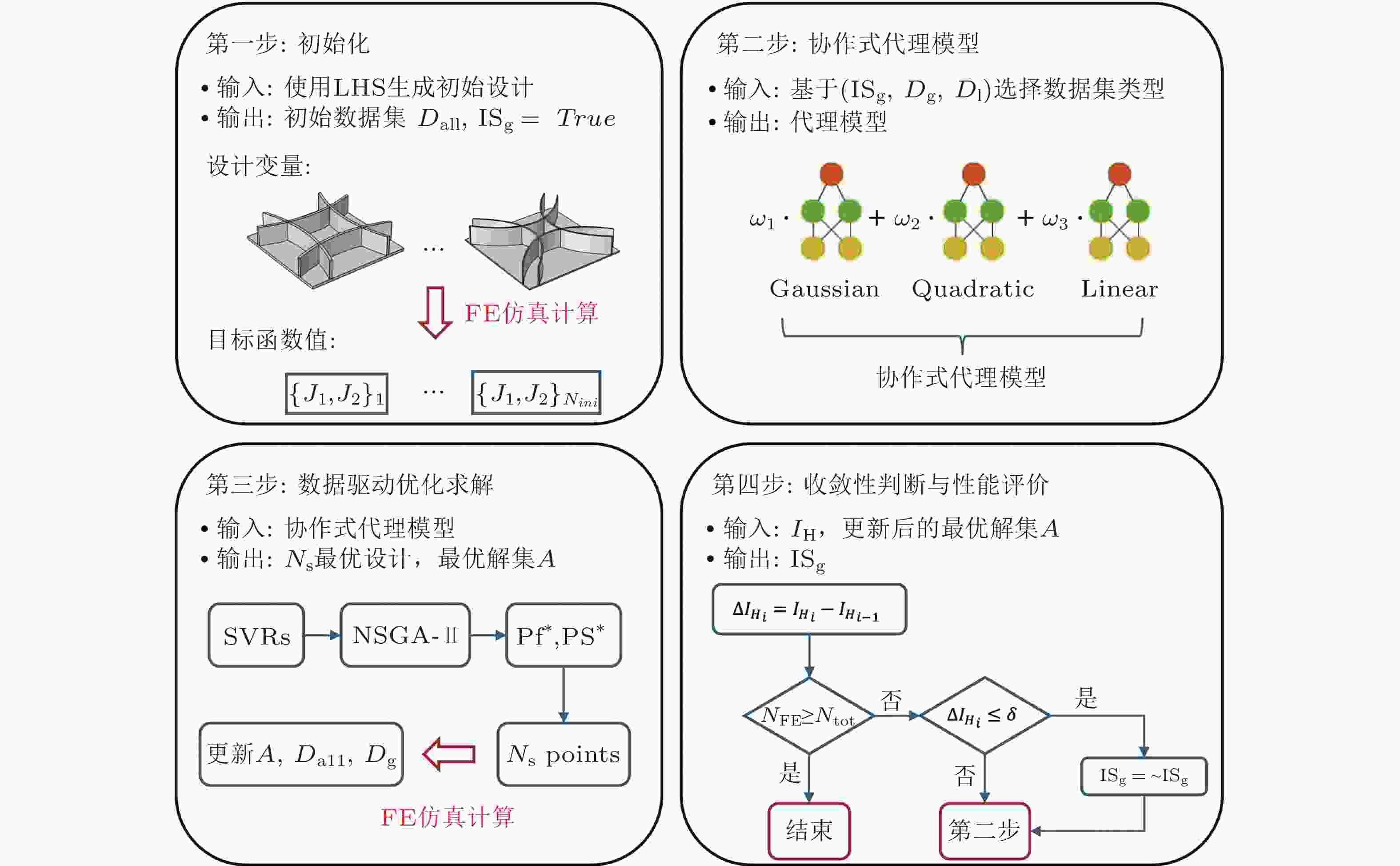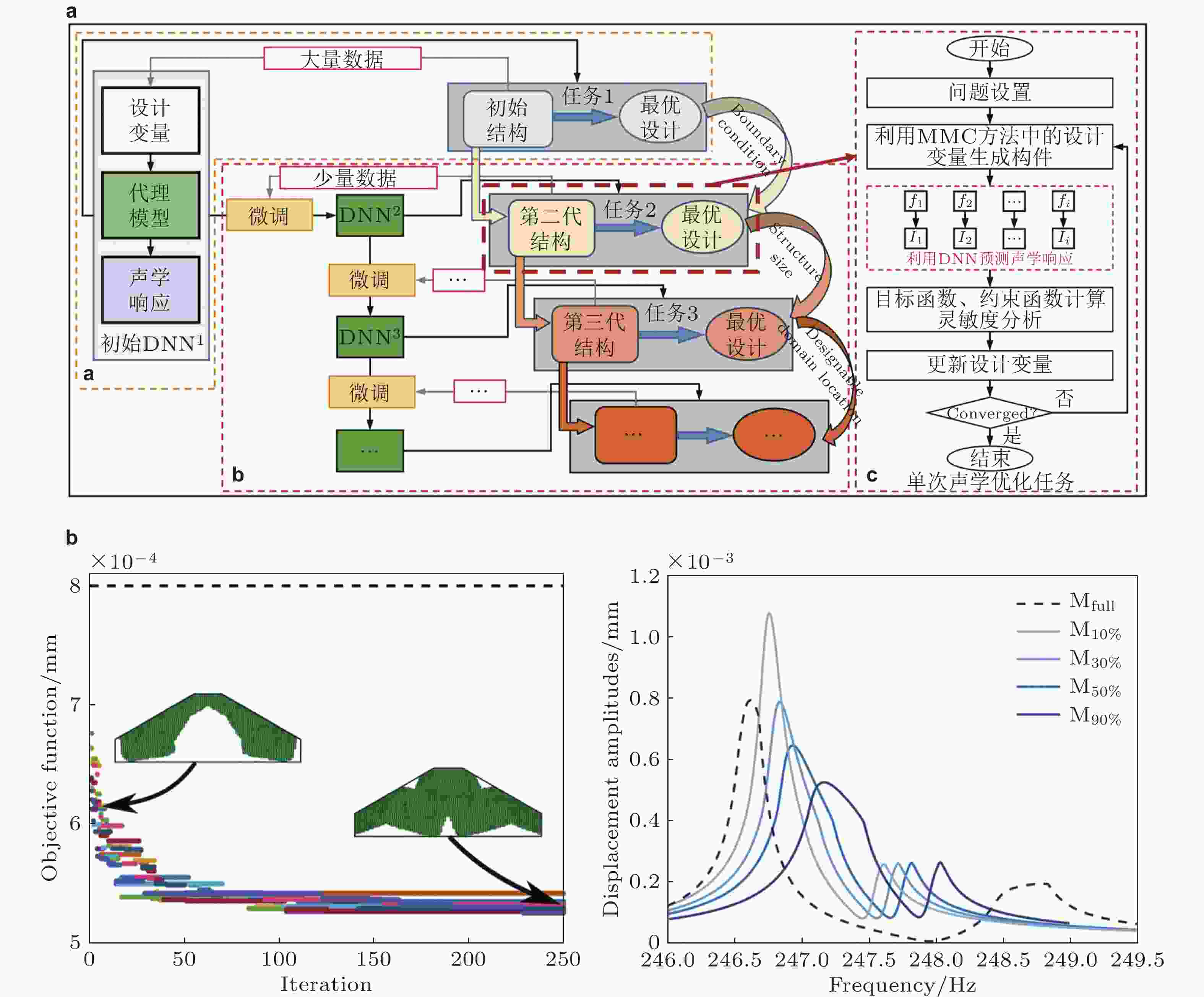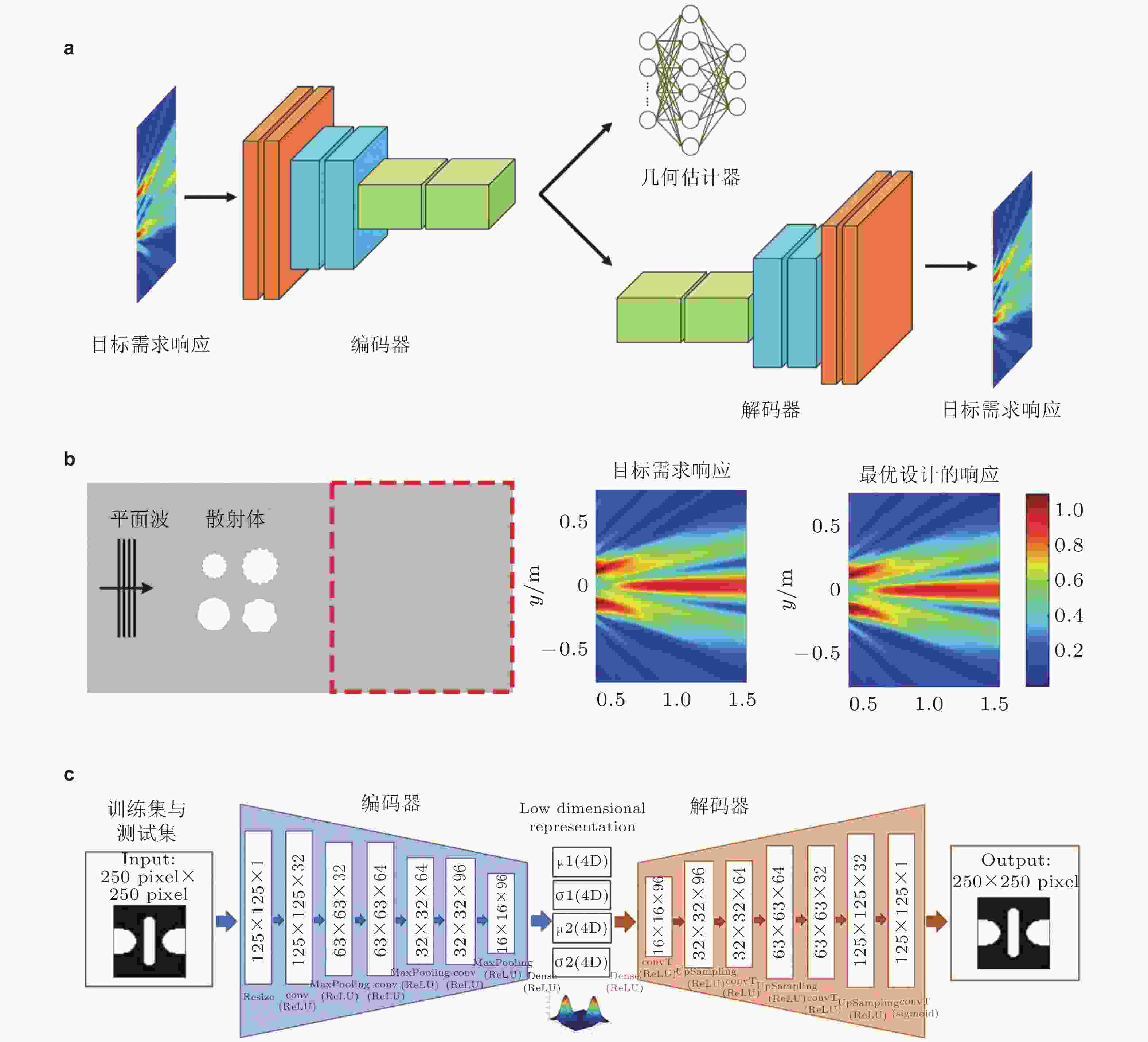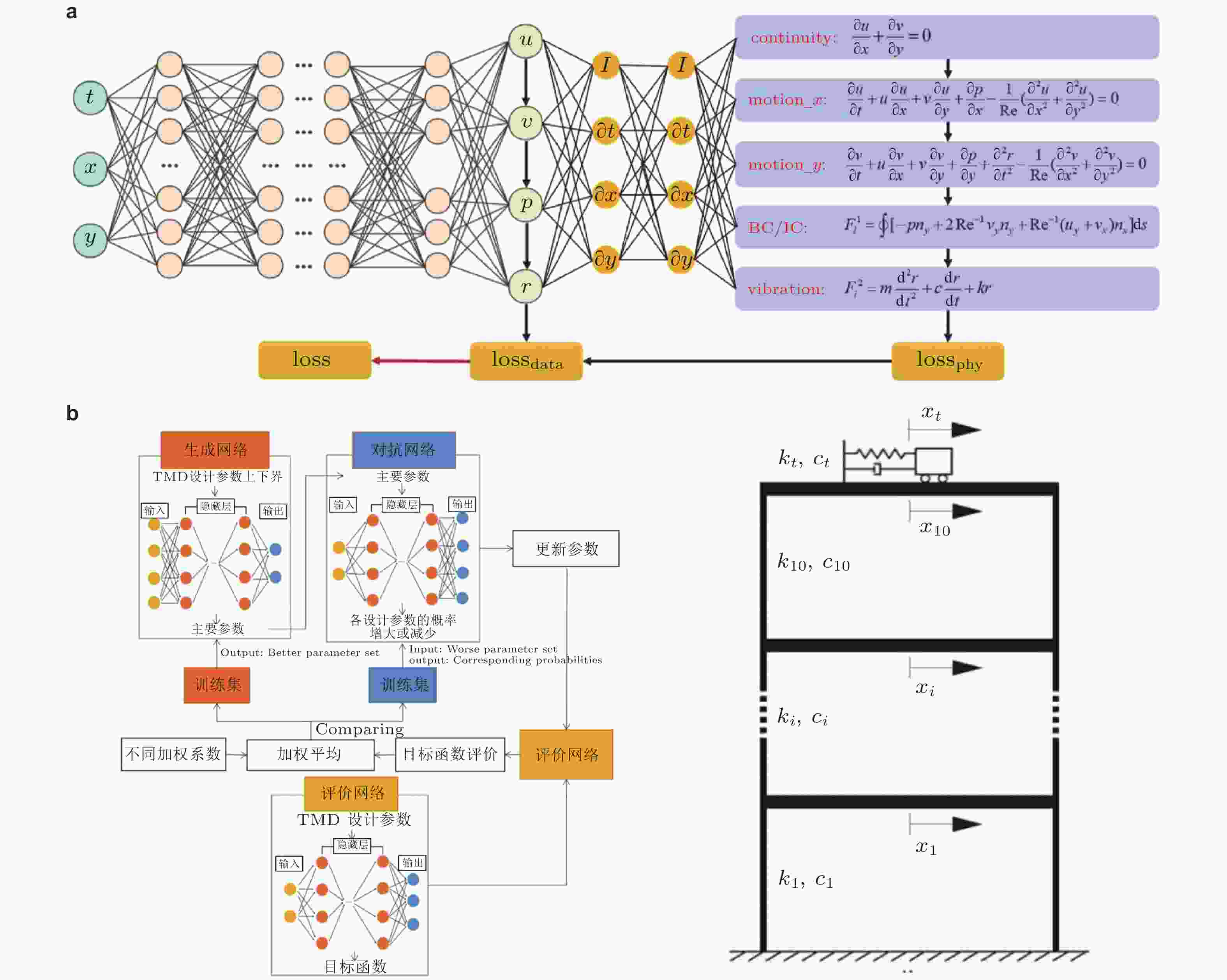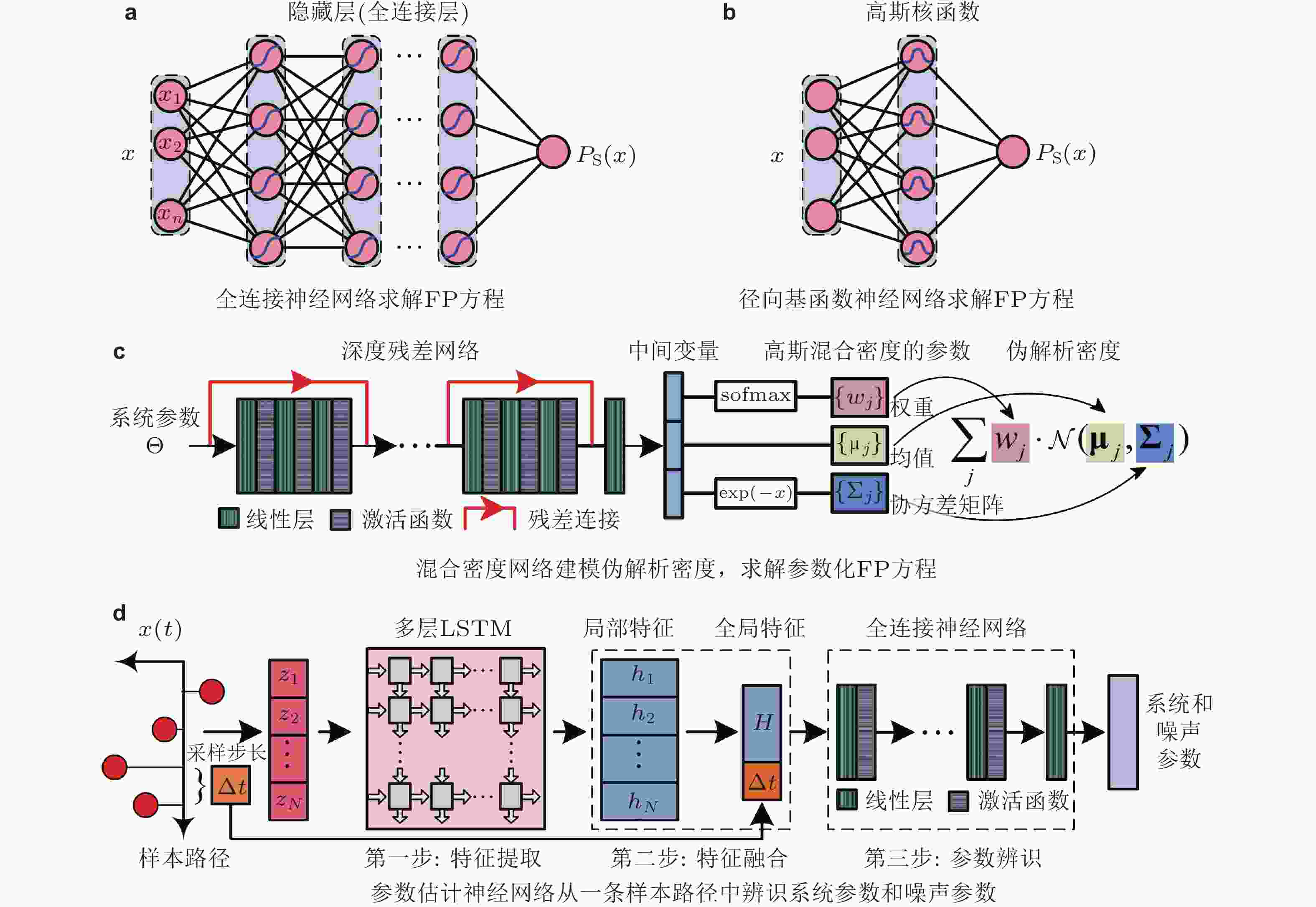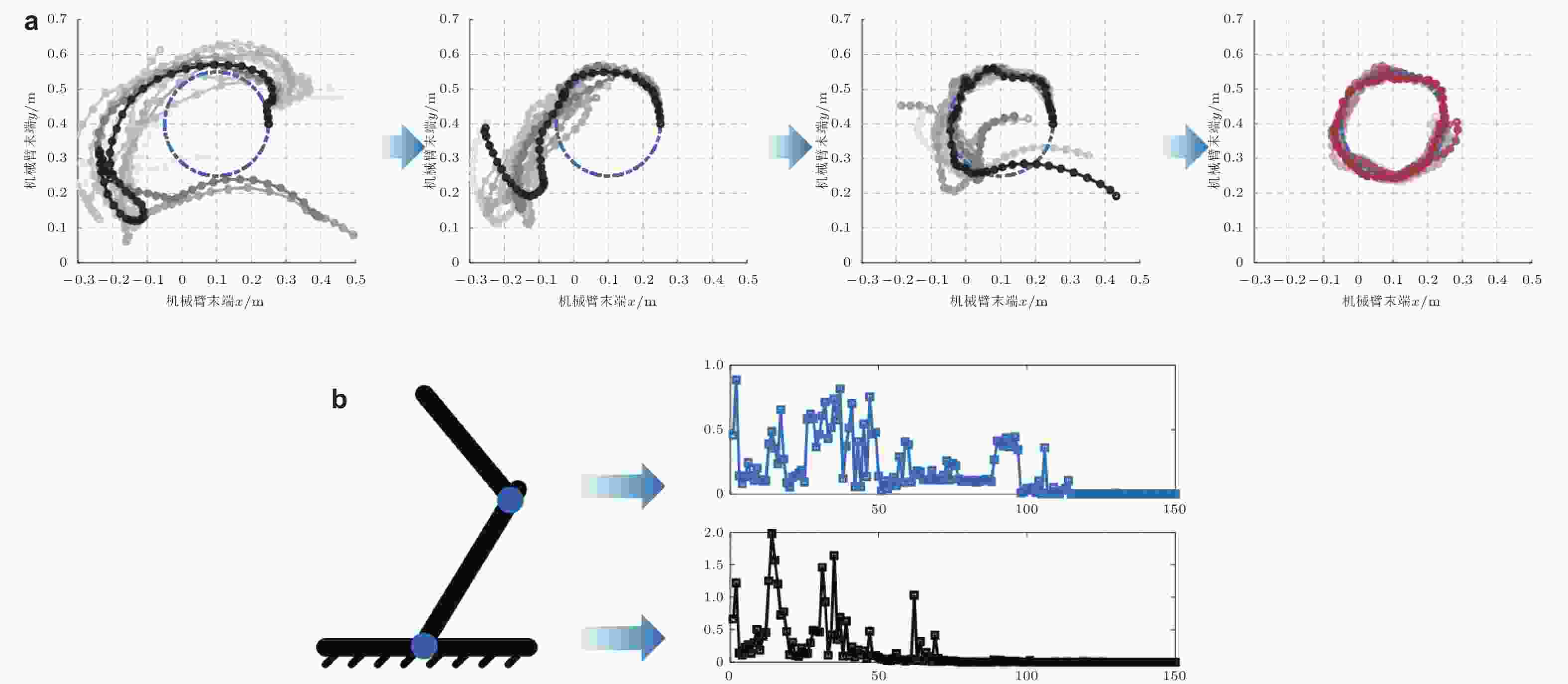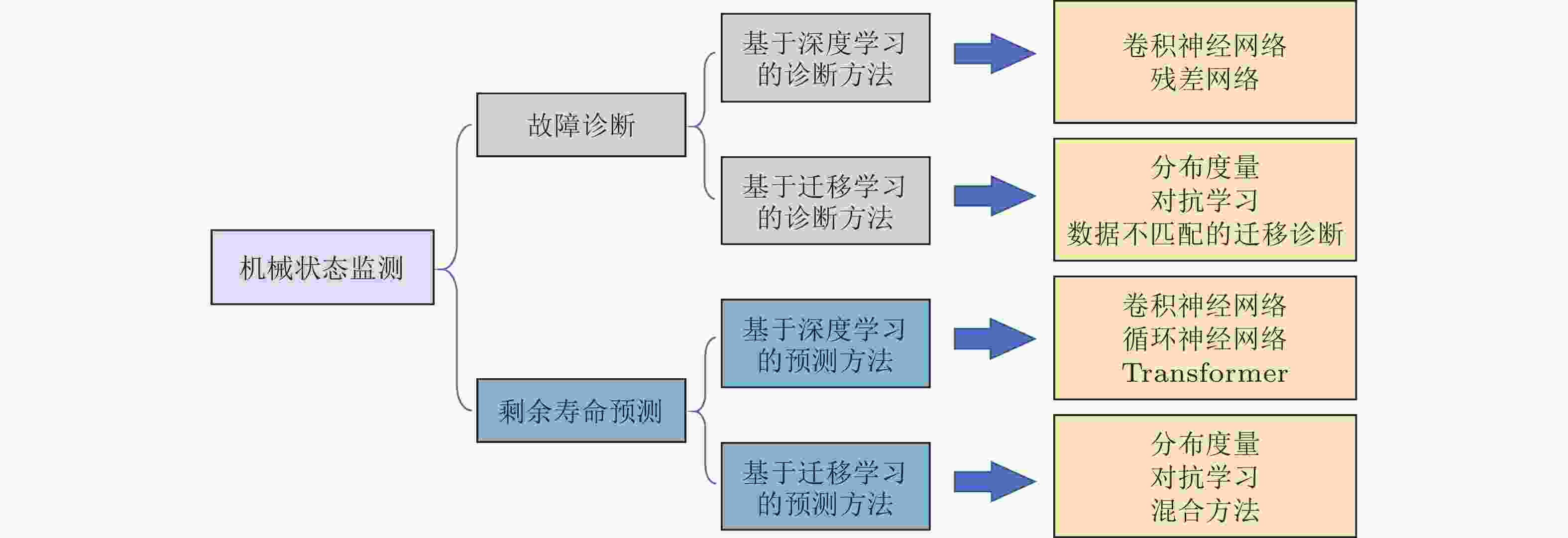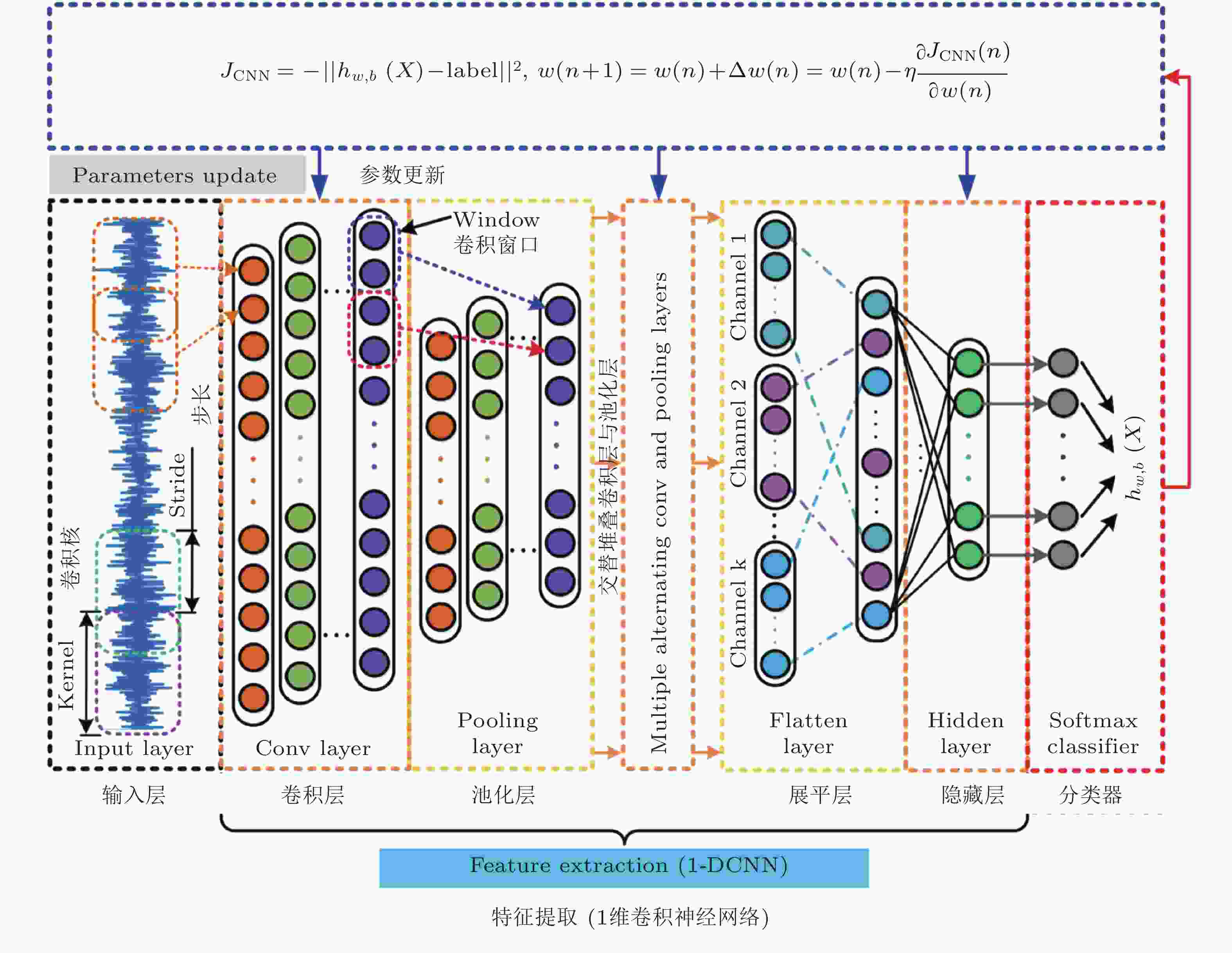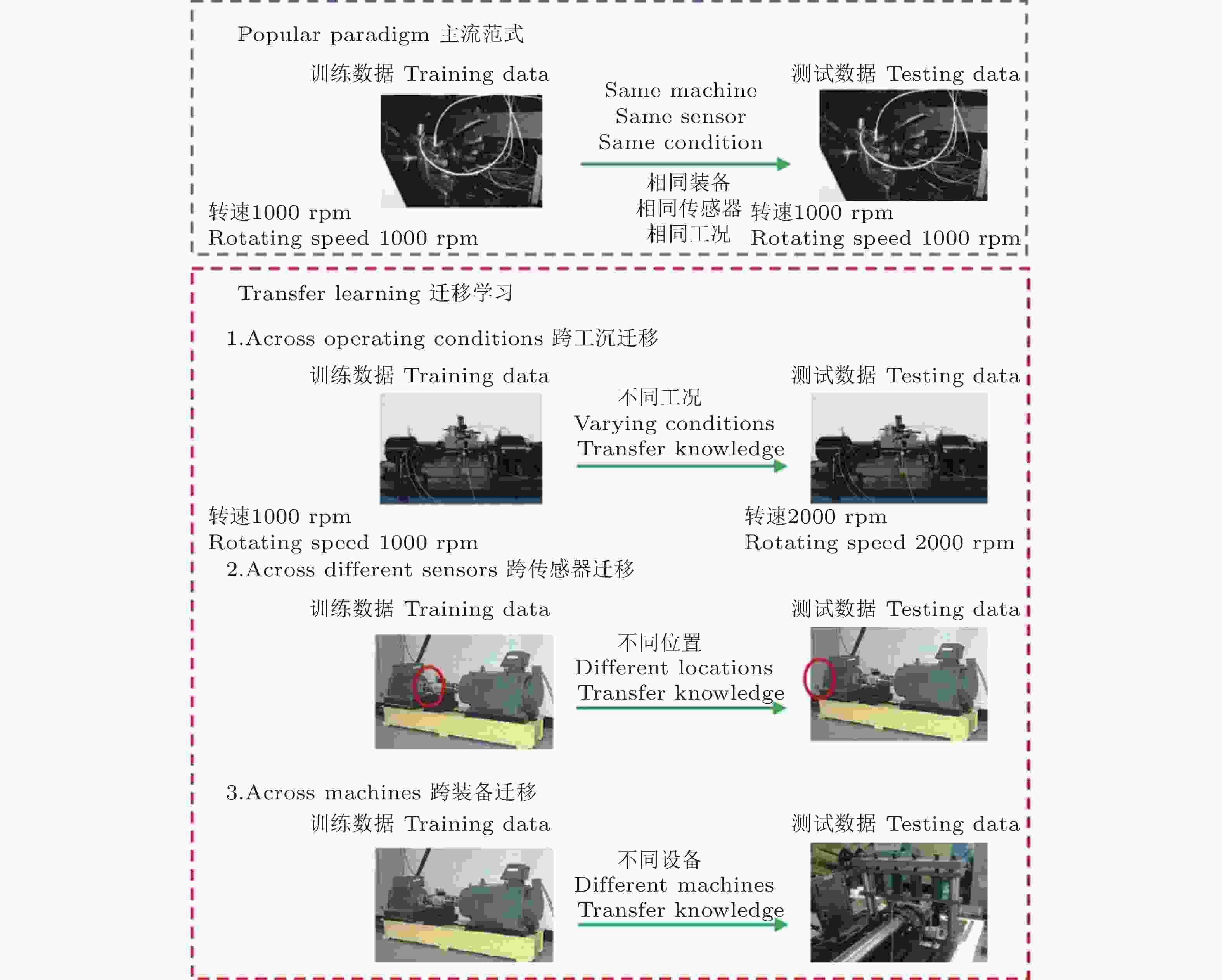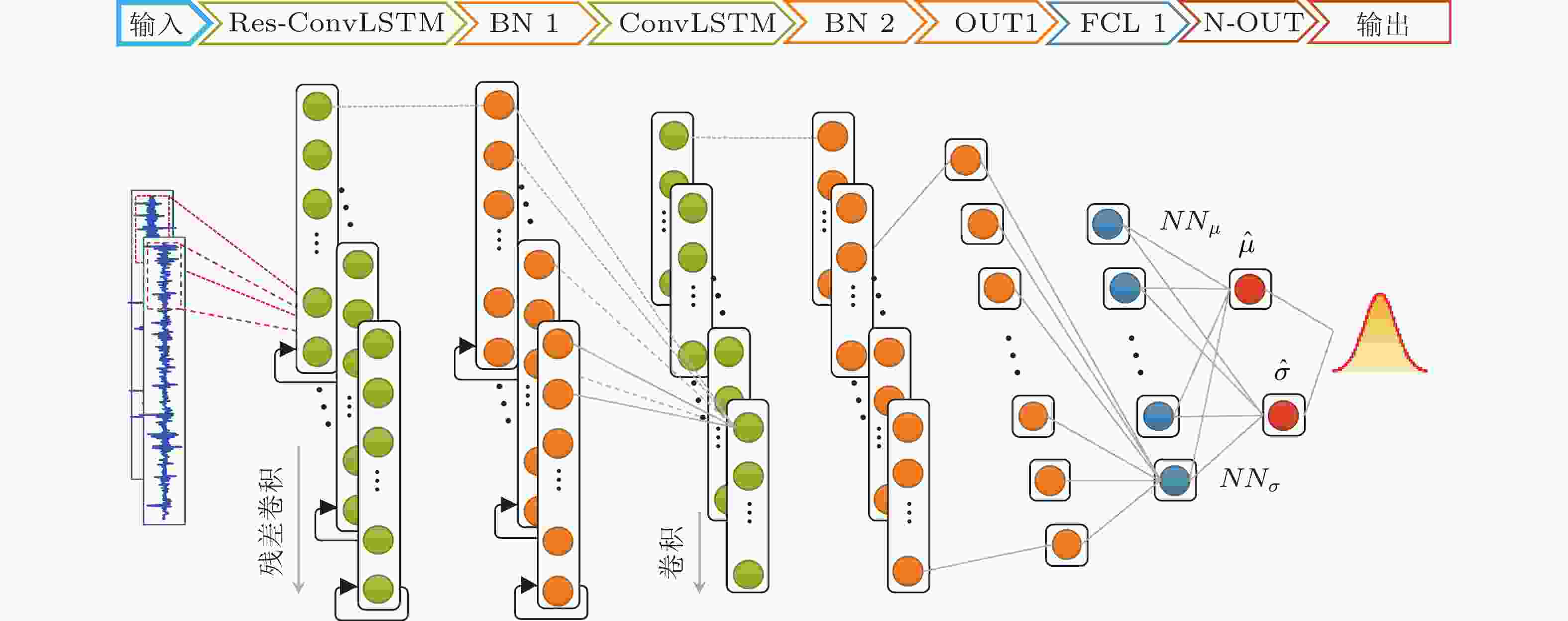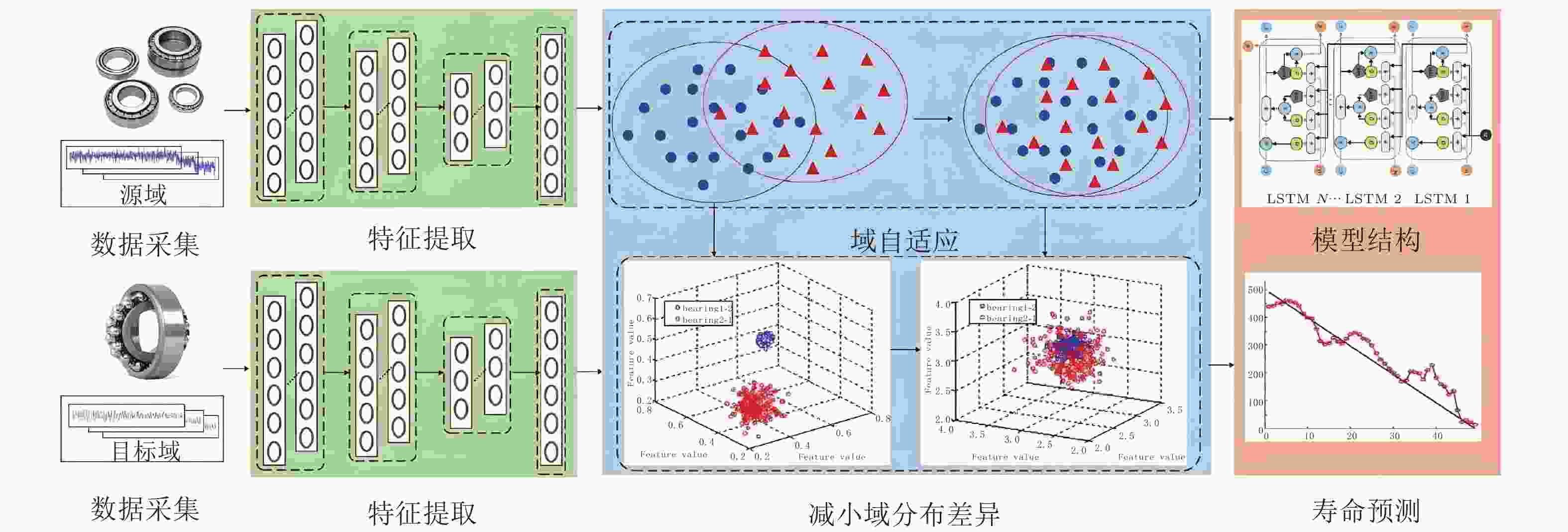-
摘要: 动力学与控制是研究系统运动规律力学机理及其调控方法的学科, 在现代工程与科学研究中具有重要作用. 来自工程结构、耦合构件间力传递和环境交互中的结构和几何非线性、接触力的非光滑性、环境干扰的不确定性和与环境多场耦合交互等因素的复杂性, 使得传统动力学建模、动力学响应预测和动力学控制的智能化变得异常困难. 数据驱动方法的快速发展为解决这些问题提供了全新思路和新的研究范式. 近年来的研究表明, 数据驱动方法不但可以解决或部分解决传统动力学方法无法解决的问题, 而且可以显著提升动力学行为预测和性能优化的能力, 为动力学与控制研究的智能化奠定必要的基础, 在复杂耦合系统的建模、分析与调控中展现出巨大的潜力与科学价值. 本文简要介绍了近年来数据驱动方法在机器人动力学建模与运动调控、跨声速气动弹性动力学建模、结构动力学设计、随机动力学、基于脑机接口技术和神经动力学模型的运动控制、机械设备故障诊断与剩余寿命预测等方面的应用研究进展, 并探讨了这些领域面临的挑战与发展趋势.Abstract: Dynamics and control is a discipline that studies the dynamic mechanisms of systems and their control strategies, and plays an important role in modern engineering and scientific research. The complexity caused by geometric nonlinearity, the non-smoothness of contact forces, and the uncertainty of environmental interferences and multi-physics problems poses significant challenges to dynamic modeling, prediction and intelligent control. The rapid development of data-driven methods has provided new ideas and new research paradigms for addressing these challenges. Recent researches have shown that data-driven methods can not only solve some problems that traditional dynamics methods cannot address but also significantly enhance the ability to predict dynamical behavior and design advanced structures. These methods lay the foundation for intelligent research in dynamics and control and demonstrate great potential and scientific value in the modeling, analysis, and regulation and control of complex systems. This paper briefly reviews the research progress of data-driven methods in areas such as robot motion control, transonic aeroelastic modeling and analysis, dynamics design, stochastic dynamics, neurodynamics, fault diagnosis and remaining useful life prediction of machinery. It also discusses the challenges and trends in these fields.
-
图 2 多自由度串联机械臂分步模型重构方法示意图(Guo & Zhang 2023)
图 3 自适应−神经网络切换控制方法示意图(Jiang et al. 2018)
图 4 非定常流动的数据驱动建模及气动弹性应用流程图(Yao et al. 2022)
图 5 数据驱动的NACA0012翼型跨声速颤振预测. (a) 颤振发散时域响应, (b) 流场压强快照(Yao et al. 2022)
图 11 基于代理模型的结构多目标优化(He et al. 2021b)
图 12 (a) 基于迁移学习的拓扑优化(Xu et al. 2024), (b) ~ (c) 考虑非线性因素的叶片阻尼器振动特性优化(Denimal et al. 2021)
图 13 (a) ~ (b) 声学散射逆向设计(Wu et al. 2022), (c) GM-βVAE逆向设计框架(Wang et al. 2022d)
图 14 (a) ~ (b) 航空发动机叶片设计(Sun et al. 2023a), (c) TNN设计方法(Liu & Yu 2022b)
图 15 (a) PIML的涡激振动预测(Tang et al. 2022), (b) 基于物理知识增强的TMD参数设计(Yang et al. 2023)
图 22 基于一维深度卷积神经网络的智能诊断模型图(Zhao et al. 2020)
图 23 智能诊断问题中的不同迁移学习场景(Ma et al. 2020)
图 24 基于分布度量的迁移诊断方法流程图(Yang et al. 2019b)
图 25 基于残差卷积长短期记忆网络的寿命预测方法模型结构图(Wang et al. 2020a)
图 26 基于分布度量的迁移预测方法流程图(Chen et al. 2023a)
-
[1] 卞文彬, 邓艾东, 刘东川, 赵敏, 刘洋, 李晶. 2023. 基于改进深度残差收缩网络的风电机组滚动轴承故障诊断方法. 机械工程学报, 59(12): 202-214 (Bian W B, Deng A D, Liu D C, Zhao M, Liu Y, Li J. 2023. Fault diagnosis method of wind turbine rolling bearing based on improved deep residual shrinkage network. Journal of Mechanical Engineering, 59(12): 202-214). doi: 10.3901/JME.2023.12.202Bian W B, Deng A D, Liu D C, Zhao M, Liu Y, Li J. 2023. Fault diagnosis method of wind turbine rolling bearing based on improved deep residual shrinkage network. Journal of Mechanical Engineering, 59(12): 202-214. doi: 10.3901/JME.2023.12.202 [2] 蔡君同, 尹强, 丁千. 2022. 非线性弹簧质量系统的数据驱动建模和响应预测. 振动工程学报, 35(5): 1101-1108 (Cai J T, Yin Q, Ding Q. 2022. Data-driven modeling and response prediction of nonlinear spring mass systems. Journal of Vibration engineering, 35(5): 1101-1108).Cai J T, Yin Q, Ding Q. 2022. Data-driven modeling and response prediction of nonlinear spring mass systems. Journal of Vibration engineering, 35(5): 1101-1108 [3] 车畅畅, 王华伟, 倪晓梅, 蔺瑞管, 熊明兰. 2021. 基于1D-CNN和Bi-LSTM的航空发动机剩余寿命预测. 机械工程学报, 57(14): 304-312 (Che C C, Wang H W, Ni X M, Lin R G, Xiong M L. 2021. Residual life prediction of aeroengine based on 1D-CNN and Bi-LSTM. Journal of Mechanical Engineering, 57(14): 304-312). doi: 10.3901/JME.2021.14.304Che C C, Wang H W, Ni X M, Lin R G, Xiong M L. 2021. Residual life prediction of aeroengine based on 1D-CNN and Bi-LSTM. Journal of Mechanical Engineering, 57(14): 304-312. doi: 10.3901/JME.2021.14.304 [4] 陈仁祥, 张雁峰, 徐向阳, 张鹏博, 杨宝军. 2024. 基于子空间域对抗判别网络的不同型号滚动轴承剩余寿命预测. 仪器仪表学报, 45(3): 119-127 (Chen R X, Zhang Y F, Xu X Y, Zhang P B, Yang B J. 2024. Remaining life prediction of different types of rolling bearings based on subspace domain adversarial discrimination network. Chinese Journal of Science Instrument, 45(3): 119-127).Chen R X, Zhang Y F, Xu X Y, Zhang P B, Yang B J. 2024. Remaining life prediction of different types of rolling bearings based on subspace domain adversarial discrimination network. Chinese Journal of Science Instrument, 45(3): 119-127. [5] 陈小前, 张泽雨, 李昱, 姚雯, 周炜恩. 2024. 深度学习赋能结构拓扑优化设计方法研究. 力学进展, 54(2): 213-258 (Chen X Q, Zhang Z Y, Li Y, Yao W, Zhou W E. 2024. Research on structure topology optimization design empowered by deep learning method. Advances in Mechanics, 54(2): 213-258). doi: 10.6052/1000-0992-23-052Chen X Q, Zhang Z Y, Li Y, Yao W, Zhou W E. 2024. Research on structure topology optimization design empowered by deep learning method. Advances in Mechanics, 54(2): 213-258 doi: 10.6052/1000-0992-23-052 [6] 陈祝云, 钟琪, 黄如意, 廖奕校, 李霁蒲, 李巍华. 2021. 基于增强迁移卷积神经网络的机械智能故障诊断. 机械工程学报, 57(21): 96-105 (Chen Z Y, Zhong Q, Huang R Y, Liao Y X, Li J P, Li W H. 2021. Intelligent fault diagnosis for machinery based on enhanced transfer convolutional neural network. Journal of Mechanical Engineering, 57(21): 96-105). doi: 10.3901/JME.2021.21.096Chen Z Y, Zhong Q, Huang R Y, Liao Y X, Li J P, Li W H. 2021. Intelligent fault diagnosis for machinery based on enhanced transfer convolutional neural network. Journal of Mechanical Engineering, 57(21): 96-105 doi: 10.3901/JME.2021.21.096 [7] 韩特, 李彦夫, 雷亚国, 李乃鹏, 李响. 2022. 融合图标签传播和判别特征增强的工业机器人关键部件半监督故障诊断方法. 机械工程学报, 58(17): 116-124 (Han T, Li Y F, Lei Y G, Li N P, Li X. 2022. Semi-supervised fault diagnosis method via graph label propagation and discriminative feature enhancement for critical components of industrial robot. Journal of Mechanical Engineering, 58(17): 116-124). doi: 10.3901/JME.2022.17.116Han T, Li Y F, Lei Y G, Li N P, Li X. 2022. Semi-supervised fault diagnosis method via graph label propagation and discriminative feature enhancement for critical components of industrial robot. Journal of Mechanical Engineering, 58(17): 116-124 doi: 10.3901/JME.2022.17.116 [8] 黄庆卿, 胡欣堪, 韩延, 林志超, 张焱. 2022. 多源域子域自适应的滚动轴承剩余寿命预测方法. 电子测量与仪器学报, 36(10): 100-107 (Huang Q Q, Hu X K, Han Y, Lin Z C, Zhang Y. 2022. Remain useful life prediction of rolling bearing based on multi-source subdomain adaption network. Journal of Electronic Measurement and Instrumentation, 36(10): 100-107).Huang Q Q, Hu X K, Han Y, Lin Z C, Zhang Y. 2022. Remain useful life prediction of rolling bearing based on multi-source subdomain adaption network. Journal of Electronic Measurement and Instrumentation, 36(10): 100-107 [9] 金肖玲, 王永, 黄志龙. 2013. 多自由度非线性随机系统的响应与稳定性. 力学进展, 43(1): 56-62 (Jin X L, Wang Y, Huang Z L. 2013. Response and stability of multi-degree-of-freedom nonlinear stochastic systems. Advances in Mechanics, 43(1): 56-62). doi: 10.6052/1000-0992-12-026Jin X L, Wang Y, Huang Z L. 2013. Response and stability of multi-degree-of-freedom nonlinear stochastic systems. Advances in Mechanics, 43(1): 56-62 doi: 10.6052/1000-0992-12-026 [10] 靳艳飞, 许鹏飞, 李永歌, 马晋忠, 许勇. 2023. 多稳态动力系统中随机共振的研究进展. 力学进展, 53(2): 357-394 (Jin Y F, Xu P F, Li Y G, Ma J Z, Xu Y. 2023. Stochastic resonance of multi-stable dynamical systems: A review. Advances in Mechanics, 53(2): 357-394). doi: 10.6052/1000-0992-22-047Jin Y F, Xu P F, Li Y G, Ma J Z, Xu Y. 2023. Stochastic resonance of multi-stable dynamical systems: A review. Advances in Mechanics, 53(2): 357-394 doi: 10.6052/1000-0992-22-047 [11] 雷亚国, 杨彬, 李乃鹏, 李响, 武通海. 2022. 跨设备的机械故障靶向迁移诊断方法. 机械工程学报, 58(12): 1-9 (Lei Y G, Yang B, Li N P, Li X, Wu T H. 2022. Targeted transfer diagnosis method across different machines. Journal of Mechanical Engineering, 58(12): 1-9). doi: 10.3901/JME.2022.12.001Lei Y G, Yang B, Li N P, Li X, Wu T H. 2022. Targeted transfer diagnosis method across different machines. Journal of Mechanical Engineering, 58(12): 1-9 doi: 10.3901/JME.2022.12.001 [12] 雷亚国, 李熹伟, 李响, 李乃鹏, 杨彬. 2025. 面向机械设备通用健康管理的智能运维大模型. 机械工程学报: 1-13 (Lei Y G, Li X W, Li X, Li N P, Yang B. 2025. Research on foundation model for general prognostics and health management of machinery. Journal of Mechanical Engineering, 1-13).Lei Y G, Li X W, Li X, Li N P, Yang B. 2025. Research on foundation model for general prognostics and health management of machinery. Journal of Mechanical Engineering, 1-13. [13] 李响, 付春霖, 雷亚国, 李乃鹏, 杨彬. 2023. 保证数据隐私的装备协同智能故障诊断联邦迁移学习方法. 机械工程学报, 59(6): 1-9 (Li X, Fu C L, Lei Y G, Li N P, Yang B. 2023. Federated transfer learning method for privacy-preserving collaborative intelligent machinery fault diagnostics. Journal of Mechanical Engineering, 59(6): 1-9). doi: 10.3901/JME.2023.06.001Li X, Fu C L, Lei Y G, Li N P, Yang B. 2023. Federated transfer learning method for privacy-preserving collaborative intelligent machinery fault diagnostics. Journal of Mechanical Engineering, 59(6): 1-9 doi: 10.3901/JME.2023.06.001 [14] 李响, 陈欣瑞, 雷亚国, 李乃鹏, 杨彬, 俞舒鹏. 2024. 动态视觉赋能的非接触式装备迁移诊断. 机械工程学报, 60(24): 1-10 (Li X, Chen X R, Lei Y G, Li N P, Yang B, Yu S P. 2024. Dynamic vision enabled contactless intelligent machine transfer diagnosis method. Journal of Mechanical Engineering, 60(24): 1-10).Li X, Chen X R, Lei Y G, Li N P, Yang B, Yu S P. 2024. Dynamic vision enabled contactless intelligent machine transfer diagnosis method. Journal of Mechanical Engineering, 60(24): 1-10 [15] 李响, 徐宜销, 雷亚国, 李熹伟, 李乃鹏, 杨彬. 2025. 面向旋转机械装备的智能故障诊断通用基础模型研究. 西安交通大学学报, 1-12 (Li X, Xu Y X, Lei Y G, Li X W, Li N P, Yang B. 2025. Research on general foundation model of intelligent fault diagnosis for rotating machines. Journal of Xi’an Jiaotong University, 1-12).Li X, Xu Y X, Lei Y G, Li X W, Li N P, Yang B. 2025. Research on general foundation model of intelligent fault diagnosis for rotating machines. Journal of Xi’an Jiaotong University, 1-12. [16] 刘华开, 丁康, 何国林, 李巍华, 林慧斌. 2024. 联合故障机理和卷积神经网络的齿轮剩余使用寿命预测方法研究. 机械工程学报, 60(12): 116-125 (Liu H K, Ding K, He G L, Li W H, Lin H B. 2024. Research on the prediction method of remaining useful life of gears by combining fault mechanism and convolutional neural network. Journal of Mechanical Engineering, 60(12): 116-125).Liu H K, Ding K, He G L, Li W H, Lin H B. 2024. Research on the prediction method of remaining useful life of gears by combining fault mechanism and convolutional neural network. Journal of Mechanical Engineering, 60(12): 116-125 [17] 卢经纬, 程相, 王飞跃. 2022. 求解微分方程的人工智能与深度学习方法: 现状及展望. 智能科学与技术学报, 4(4): 461-476 (Lu J W, Cheng X, Wang F Y. 2022. Artificial intelligence and deep learning methods for solving differential equations: The state of the art and prospects. Chinese Journal of Intelligent Science and Technology, 4(4): 461-476). doi: 10.11959/j.issn.2096-6652.202255Lu J W, Cheng X, Wang F Y. 2022. Artificial intelligence and deep learning methods for solving differential equations: The state of the art and prospects. Chinese Journal of Intelligent Science and Technology, 4(4): 461-476 doi: 10.11959/j.issn.2096-6652.202255 [18] 孙建桥, 熊夫睿. 2017. 非线性动力学系统全局分析之外的胞映射方法新发展. 力学进展, 47(1): 150-177 (Sun J Q, Xiong F R. 2017. Cell mapping methods-beyond global analysis of nonlinear dynamic systems. Advances in Mechanics, 47(1): 150-177).Sun J Q, Xiong F R. 2017. Cell mapping methods-beyond global analysis of nonlinear dynamic systems. Advances in Mechanics, 47(1): 150-177. [19] 许勇, 裴斌, 徐伟. 2017. 随机平均原理研究若干进展. 动力学与控制学报, 15(3): 193-199 (Xu Y, Pei B, Xu W. 2017. Some recent developments of stochastic averaging principle. Journal of Dynamics and Control, 15(3): 193-199). doi: 10.6052/1672-6553-2017-022Xu Y, Pei B, Xu W. 2017. Some recent developments of stochastic averaging principle. Journal of Dynamics and Control, 15(3): 193-199 doi: 10.6052/1672-6553-2017-022 [20] 杨强, 孟松鹤, 仲政, 解维华, 郭早阳, 金华, 张幸红. 2020. 力学研究中“大数据”的启示、应用与挑战. 力学进展, 50(1): 202011 (Yang Q, Meng S H, Zhong Z, Xie W H, Guo Z Y, Jin H, Zhang X H. 2020. Big data in mechanical research: Potentials, applications and challenges. Advances in Mechanics, 50(1): 202011). doi: 10.6052/1000-0992-19-002Yang Q, Meng S H, Zhong Z, Xie W H, Guo Z Y, Jin H, Zhang X H. 2020. Big data in mechanical research: Potentials, applications and challenges. Advances in Mechanics, 50(1): 202011 doi: 10.6052/1000-0992-19-002 [21] 张国栋, 尹强, 羊柳. 2024. 基于格拉姆角场和PSO-CNN的滚动轴承故障诊断方法. 兵器装备工程学报, 45(4): 301-308 (Zhang G D, Yin Q, Yang L. 2024. Rolling bearing fault diagnosis method based on Gramian angle field and PSO-CNN. Journal of Ordnance Equipment Engineering, 45(4): 301-308). doi: 10.11809/bqzbgcxb2024.04.039Zhang G D, Yin Q, Yang L. 2024. Rolling bearing fault diagnosis method based on Gramian angle field and PSO-CNN. Journal of Ordnance Equipment Engineering, 45(4): 301-308 doi: 10.11809/bqzbgcxb2024.04.039 [22] 张伟伟, 王旭, 寇家庆. 2023. 面向流体力学的多范式融合研究展望. 力学进展, 53(2): 433-467 (Zhang W W, Wang X, Kou J Q. 2023. Prospects of multi-paradigm fusion methods for fluid mechanics research. Advances in Mechanics, 53(2): 433-467). doi: 10.6052/1000-0992-22-050Zhang W W, Wang X, Kou J Q. 2023. Prospects of multi-paradigm fusion methods for fluid mechanics research. Advances in Mechanics, 53(2): 433-467 doi: 10.6052/1000-0992-22-050 [23] Abadía I, Naveros F, Garrido J A, Ros E, Luque N R. 2021. On robot compliance: A cerebellar control approach. IEEE Transactions on Cybernetics, 51(5): 2476-2489. doi: 10.1109/TCYB.2019.2945498 [24] Abdar M, Pourpanah F, Hussain S, Rezazadegan D, Liu L, Ghavamzadeh M, Fieguth P, Cao X, Khosravi A, Acharya U R, Makarenkov V, Nahavandi S. 2021. A review of uncertainty quantification in deep learning: Techniques, applications and challenges. Information Fusion, 76: 243-297. doi: 10.1016/j.inffus.2021.05.008 [25] Agrawal S, Sarkar S, Srivastava G, Maddikunta P K R, Gadekallu T R. 2021. Genetically optimized prediction of remaining useful life. Sustainable Computing: Informatics and Systems, 31: 100565. doi: 10.1016/j.suscom.2021.100565 [26] Ahmed W W, Farhat M, Zhang X, Wu Y. 2021. Deterministic and probabilistic deep learning models for inverse design of broadband acoustic cloak. Physical Review Research, 3(1): 013142. doi: 10.1103/PhysRevResearch.3.013142 [27] Ainapure A, Li X, Singh J, Yang Q, Lee J. 2020. Deep learning-based cross-machine health identification method for vacuum pumps with domain adaptation. Procedia Manufacturing, 48: 1088-1093. doi: 10.1016/j.promfg.2020.05.149 [28] Amuso V J, Enslin J. 2007. The strength pareto evolutionary algorithm 2 (SPEA2) applied to simultaneous multi-mission waveform design 2007 international waveform diversity and design conference: 407-417. [29] Askarinejad S E, Fahim A, Yazdi M R H, Masouleh M T. 2019. Data-driven identification of the jacobian matrix of a 2-DoF spherical parallel manipulator 2019 7th international conference on robotics and mechatronics (ICRoM): 229-234. [30] Åström K J, M M R. 2008. Feedback systems: An introduction for scientists and engineers. Princeton University Press. [31] Bai J, Liu G-R, Gupta A, Alzubaidi L, Feng X-Q, Gu Y. 2023. Physics-informed radial basis network (PIRBN): A local approximating neural network for solving nonlinear partial differential equations. Computer Methods in Applied Mechanics and Engineering, 415: 116290. doi: 10.1016/j.cma.2023.116290 [32] Bai Z, Song S. 2023. Physics-informed neural network for first-passage reliability assessment of structural dynamic systems. Computers & Structures, 289: 107189. [33] Balm M F, Abid A, Zou J. 2019. Concrete autoencoders: Differentiable feature selection and reconstruction. Kamalika C, Ruslan S, Proceedings of the 36th International Conference on Machine Learning. PMLR; Long Beach, California, 444-453. [34] Ban N, Yamazaki W. 2021. Black-box function aerodynamic topology optimization algorithm via machine learning technologies. AIAA Journal, 59(12): 5174-5185. doi: 10.2514/1.J059605 [35] Boucheny C, Carrillo R, Ros E, et al. 2005. Real-time spiking neural network: An adaptive cerebellar model. International Work-Conference on Artificial Neural Networks, 3512: 136-144. [36] Brandman D M, Hosman T, Saab J, Burkhart M C, Shanahan B E, Ciancibello J G, Sarma A A, Milstein D J, Vargas-Irwin C E, Franco B, Kelemen J, Blabe C, Murphy B A, Young D R, Willett F R, Pandarinath C, Stavisky S D, Kirsch R F, Walter B L, Bolu Ajiboye A, Cash S S, Eskandar E N, Miller J P, Sweet J A, Shenoy K V, Henderson J M, Jarosiewicz B, Harrison M T, Simeral J D, Hochberg L R. 2018. Rapid calibration of an intracortical brain–computer interface for people with tetraplegia. Journal of Neural Engineering, 15(2). [37] Brett T, Ajelli M, Liu Q-H, Krauland M G, Grefenstette J J, van Panhuis W G, Vespignani A, Drake J M, Rohani P. 2020. Detecting critical slowing down in high-dimensional epidemiological systems. PLOS Computational Biology, 16(3): e1007679. doi: 10.1371/journal.pcbi.1007679 [38] Broomhead D S, Lowe D. 1988. Multivariable functional interpolation and adaptive networks. Complex Systems, 2(3): 321-355. [39] Brown P, McPhee J. 2018. A 3D ellipsoidal volumetric foot–ground contact model for forward dynamics. Multibody System Dynamics, 42(4): 447-467. doi: 10.1007/s11044-017-9605-4 [40] Bruder D, Fu X, Gillespie R B, Remy C D, Vasudevan R. 2021. Koopman-based control of a soft continuum manipulator under variable loading conditions. IEEE Robotics and Automation Letters, 6(4): 6852-6859. doi: 10.1109/LRA.2021.3095268 [41] Brunton S L, Kutz J N. 2022. Data-driven science and engineering: Machine learning, dynamical systems, and control. Cambridge University Press. [42] Brunton S L, Noack B R, Koumoutsakos P. 2020. Machine learning for fluid mechanics. Annual Review of Fluid Mechanics, 52: 477-508. doi: 10.1146/annurev-fluid-010719-060214 [43] Brunton S L, Proctor J L, Kutz J N. 2016. Discovering governing equations from data by sparse identification of nonlinear dynamical systems. Proceedings of the National Academy of Sciences, 113(15): 3932-3937. doi: 10.1073/pnas.1517384113 [44] Budolak D, Leonessa A. 2020. Guaranteed parameter estimation of hunt-crossley model with chebyshev polynomial approximation for teleoperation 2020 IEEE/RSJ international conference on intelligent robots and systems (IROS). 7330-7335. [45] Bui-Thanh T, Damodaran M, Willcox K. 2004. Aerodynamic data reconstruction and inverse design using proper orthogonal decomposition. AIAA Journal, 42(8): 1505-1516. doi: 10.2514/1.2159 [46] Bury T M, Dylewsky D, Bauch C T, Anand M, Glass L, Shrier A, Bub G. 2023. Predicting discrete-time bifurcations with deep learning. Nature Communications, 14(1): 6331. doi: 10.1038/s41467-023-42020-z [47] Bury T M, Sujith R I, Pavithran I, Scheffer M, Lenton T M, Anand M, Bauch C T. 2021. Deep learning for early warning signals of tipping points. Proceedings of the National Academy of Sciences, 118(39): e2106140118. doi: 10.1073/pnas.2106140118 [48] Callaham J L, Maeda K, Brunton S L. 2019. Robust flow reconstruction from limited measurements via sparse representation. Physical Review Fluids, 4(10): 103907. doi: 10.1103/PhysRevFluids.4.103907 [49] Cao L, Wu J, Zhang Z, Zhang C, Wan W, Bao J, Gao Y. 2024. Design optimization of elastic metamaterials with multilayered honeycomb structure by Kriging surrogate model and genetic algorithm. Structural and Multidisciplinary Optimization, 67(5): 82. doi: 10.1007/s00158-024-03768-0 [50] Carrillo R R, Ros E, Boucheny C, Coenen O J M D. 2008. A real-time spiking cerebellum model for learning robot control. Biosystems, 94(1-2): 18-27. doi: 10.1016/j.biosystems.2008.05.008 [51] Chadha G S, Shah S R B, Schwung A, Ding S X. 2022. Shared temporal attention transformer for remaining useful lifetime estimation. IEEE Access, 10: 74244-74258. doi: 10.1109/ACCESS.2022.3187702 [52] Champion K, Lusch B, Kutz J N, Brunton S L. 2019. Data-driven discovery of coordinates and governing equations. Proceedings of the National Academy of Sciences, 116(45): 22445-22451. doi: 10.1073/pnas.1906995116 [53] Chaturantabut S, Sorensen D C. 2010. Nonlinear model reduction via discrete empirical interpolation. SIAM Journal on Scientific Computing, 32(5): 2737-2764. doi: 10.1137/090766498 [54] Chen G, Li D, Zhou Q, Da Ronch A, Li Y. 2018. Efficient aeroelastic reduced order model with global structural modifications. Aerospace Science and Technology, 76: 1-13. doi: 10.1016/j.ast.2018.01.023 [55] Chen J, Huang R, Chen Z, Mao W, Li W. 2023a. Transfer learning algorithms for bearing remaining useful life prediction: A comprehensive review from an industrial application perspective. Mechanical Systems and Signal Processing, 193: 110239. doi: 10.1016/j.ymssp.2023.110239 [56] Chen X, Jin X, Huang Z. 2023b. Data-driven identification for approximate analytical solution of first-passage problem. Probabilistic Engineering Mechanics, 73: 103467. doi: 10.1016/j.probengmech.2023.103467 [57] Chen X, Jin X, Huang Z. 2023c. Data-driven method for identifying the expression of the Lyapunov exponent from random data. International Journal of Non-Linear Mechanics, 148: 104268. doi: 10.1016/j.ijnonlinmec.2022.104268 [58] Chen Z, Lai S-K, Yang Z. 2024. AT-PINN: Advanced time-marching physics-informed neural network for structural vibration analysis. Thin-Walled Structures, 196: 111423. doi: 10.1016/j.tws.2023.111423 [59] Chen Z, Liu Y, Sun H. 2021. Physics-informed learning of governing equations from scarce data. Nature Communications, 12(1): 6136. doi: 10.1038/s41467-021-26434-1 [60] Cheng F, Liu H. 2024. Surrogate model-based multi-objective optimization algorithm for train-ballast turnout system: Balancing safety and vibration damping in parameter design. Engineering Structures, 304: 117685. doi: 10.1016/j.engstruct.2024.117685 [61] Chu H K, Hayashibe M. 2020. Discovering interpretable dynamics by sparsity promotion on energy and the lagrangian. IEEE Robotics and Automation Letters, 5(2): 2154-2160. doi: 10.1109/LRA.2020.2970626 [62] Coello C A C, Pulido G T, Lechuga M S. 2004. Handling multiple objectives with particle swarm optimization. IEEE Transactions on Evolutionary Computation, 8(3): 256-279. doi: 10.1109/TEVC.2004.826067 [63] Craig J J. 2018. Introduction to robotics: Mechanics and control. Fourth Edition, Stanford. [64] Dakos V, Carpenter S R, Brock W A, Ellison A M, Guttal V, Ives A R, Kéfi S, Livina V, Seekell D A, van Nes E H, Scheffer M. 2012. Methods for detecting early warnings of critical transitions in time series illustrated using simulated ecological data. PLOS ONE, 7(7): e41010. doi: 10.1371/journal.pone.0041010 [65] Danai K, La Cava W G. 2021. Controller design by symbolic regression. Mechanical Systems and Signal Processing, 151: 107348. doi: 10.1016/j.ymssp.2020.107348 [66] de Pater I, Mitici M. 2023. Developing health indicators and RUL prognostics for systems with few failure instances and varying operating conditions using a LSTM autoencoder. Engineering Applications of Artificial Intelligence, 117: 105582. doi: 10.1016/j.engappai.2022.105582 [67] Deb K, Pratap A, Agarwal S, Meyarivan T. 2002. A fast and elitist multiobjective genetic algorithm: NSGA-II. IEEE Transactions on Evolutionary Computation, 6(2): 182-197. doi: 10.1109/4235.996017 [68] Deng Y, Huang D, Du S, Li G, Zhao C, Lv J. 2021. A double-layer attention based adversarial network for partial transfer learning in machinery fault diagnosis. Computers in Industry, 127: 103399. doi: 10.1016/j.compind.2021.103399 [69] Denimal E, El Haddad F, Wong C, Salles L. 2021. Topological optimization of under-platform dampers with moving morphable components and global optimization algorithm for nonlinear frequency response. Journal of Engineering for Gas Turbines and Power, 143(2): 021021. doi: 10.1115/1.4049666 [70] Denimal E, Nechak L, Sinou J J, Nacivet S. 2018. A novel hybrid surrogate model and its application on a mechanical system subjected to friction-induced vibration. Journal of Sound and Vibration, 434: 456-474. doi: 10.1016/j.jsv.2017.08.005 [71] Dey S, Yoshida T, Schilling A F. 2020. Feasibility of training a random forest model with incomplete user-specific data for devising a control strategy for active biomimetic ankle. Frontiers in Bioengineering and Biotechnology, 8: 855. doi: 10.3389/fbioe.2020.00855 [72] Dhiman H S, Bhanushali D, Su C-L, Berghout T, Amirat Y, Benbouzid M. 2023. Enhancing wind turbine reliability through proactive high speed bearing prognosis based on adaptive threshold and gated recurrent unit networks IECON 2023-49th Annual Conference of the IEEE Industrial Electronics Society. IEEE, 1-6. [73] Ding H, Chen L-Q. 2020. Designs, analysis, and applications of nonlinear energy sinks. Nonlinear Dynamics, 100(4): 3061-3107. doi: 10.1007/s11071-020-05724-1 [74] Ding Y, Jia M. 2022. Convolutional transformer: An enhanced attention mechanism architecture for remaining useful life estimation of bearings. IEEE Transactions on Instrumentation and Measurement, 71: 3515010. [75] Dong X, Bai Y-L, Lu Y, Fan M. 2023. An improved sparse identification of nonlinear dynamics with akaike information criterion and group sparsity. Nonlinear Dynamics, 111(2): 1485-1510. doi: 10.1007/s11071-022-07875-9 [76] Drmač Z, Gugercin S. 2016. A new selection operator for the discrete empirical interpolation method—Improved a priori error bound and extensions. SIAM Journal on Scientific Computing, 38(2): A631-A648 [77] Du X, Fu Q. 2024. Surrogate model-based multi-objective design optimization of vibration suppression effect of acoustic black holes and damping materials on a rectangular plate. Applied Acoustics, 217: 109837. doi: 10.1016/j.apacoust.2023.109837 [78] Dubois P, Gomez T, Planckaert L, Perret L. 2022. Machine learning for fluid flow reconstruction from limited measurements. Journal of Computational Physics, 448: 110733. doi: 10.1016/j.jcp.2021.110733 [79] Dura-Bernal S, Neymotin S A, Kerr C C, Sivagnanam S, Majumdar A, Francis J T, Lytton W W. 2017. Evolutionary algorithm optimization of biological learning parameters in a biomimetic neuroprosthesis. IBM Journal of Research and Development, 61(2/3): 6: 1-6: 14 [80] Erichson N B, Mathelin L, Yao Z, Brunton S L, Mahoney M W, Kutz J N. 2020. Shallow neural networks for fluid flow reconstruction with limited sensors. Proc Math Phys Eng Sci, 476: 20200097. [81] Eslamy M, Oswald F, Schilling A F. 2020. Estimation of knee angles based on thigh motion: A functional approach and implications for high-level controlling of active prosthetic knees. IEEE Control Systems, 40(3): 49-61. doi: 10.1109/MCS.2020.2976384 [82] Evangeline S I, Darwin S, Raj E F I. 2024. A deep residual neural network model for synchronous motor fault diagnostics. Applied Soft Computing, 160: 111683. doi: 10.1016/j.asoc.2024.111683 [83] Everson R M, Sirovich L. 1995. Karhunen–Loève procedure for gappy data. Journal of The Optical Society of America A-optics Image Science and Vision, 12(8): 1657-1664. doi: 10.1364/JOSAA.12.001657 [84] Ezati M, Brown P, Ghannadi B, McPhee J. 2020. Comparison of direct collocation optimal control to trajectory optimization for parameter identification of an ellipsoidal foot–ground contact model. Multibody System Dynamics, 49(1): 71-93. doi: 10.1007/s11044-020-09731-3 [85] Felleman D J, Essen D C V. 1991. Distributed hierarchical processing in the primate cerebral cortex. Cereb. Cortex N. Y. N, 1(1): 1-47. [86] Feng J, Wang X, Liu Q, Li Y, Xu Y. 2023. Deep learning-based parameter estimation of stochastic differential equations driven by fractional Brownian motions with measurement noise. Communications in Nonlinear Science and Numerical Simulation, 127: 107589. doi: 10.1016/j.cnsns.2023.107589 [87] Feng J, Wang X, Liu Q, Xu Y, Kurths J. 2025. Fusing deep learning features for parameter identification of a stochastic airfoil system. Nonlinear Dynamics, 113(5): 4211-4233. [88] Fernández J, Schütze O, Hernández C, Sun J-Q, Xiong F-R. 2016. Parallel simple cell mapping for multi-objective optimization. Engineering Optimization, 48(11): 1845-1868. doi: 10.1080/0305215X.2016.1145215 [89] Fetz E E. 2007. Volitional control of neural activity: Implications for brain–computer interfaces. The Journal of Physiology, 579(3): 571-579. doi: 10.1113/jphysiol.2006.127142 [90] Firbas N, Garibo-i-Orts Ò, Garcia-March M Á, Conejero J A. 2023. Characterization of anomalous diffusion through convolutional transformers. Journal of Physics A: Mathematical and Theoretical, 56(1): 014001. doi: 10.1088/1751-8121/acafb3 [91] Flesher S N, Downey J E, Weiss J M, Hughes C L, Herrera A J, Tyler-Kabara E C, Boninger M L, Collinger J L, Gaunt R A. 2021. A brain-computer interface that evokes tactile sensations improves robotic arm control. Science, 372(6544): 831-836. doi: 10.1126/science.abd0380 [92] Forrester A, Keane A. 2008. Engineering design via surrogate modelling: A practical guide. John Wiley & Sons. [93] Forrester A I J, Keane A J. 2009. Recent advances in surrogate-based optimization. Progress in Aerospace Sciences, 45(1): 50-79. [94] Fu S, Zhang Y, Lin L, Zhao M, Zhong S-S. 2021. Deep residual LSTM with domain-invariance for remaining useful life prediction across domains. Reliability Engineering & System Safety, 216: 108012. [95] Fukami K, Murata T, Zhang K, Fukagata K. 2021. Sparse identification of nonlinear dynamics with low-dimensionalized flow representations. Journal of Fluid Mechanics, 926: A10. doi: 10.1017/jfm.2021.697 [96] Gao C, Zhang W, Li X, Liu Y, Quan J, Ye Z, Jiang Y. 2017. Mechanism of frequency lock-in in transonic buffeting flow. Journal of Fluid Mechanics, 818: 528-561. doi: 10.1017/jfm.2017.120 [97] Gao T, Liu Y-J, Li D, Tong S, Li T. 2021. Adaptive neural control using tangent time-varying BLFs for a class of uncertain stochastic nonlinear systems with full state constraints. IEEE Transactions on Cybernetics, 51(4): 1943-1953. doi: 10.1109/TCYB.2019.2906118 [98] Gauthier D J, Bollt E, Griffith A, Barbosa W A S. 2021. Next generation reservoir computing. Nature Communications, 12(1): 5564. doi: 10.1038/s41467-021-25801-2 [99] Ghorbanpour A. 2023. Cooperative robot manipulators dynamical modeling and control: An overview. Dynamics, 3(4): 820-854. doi: 10.3390/dynamics3040045 [100] Ghorvei M, Kavianpour M, Beheshti M T, Ramezani A. 2023. Spatial graph convolutional neural network via structured subdomain adaptation and domain adversarial learning for bearing fault diagnosis. Neurocomputing, 517: 44-61. doi: 10.1016/j.neucom.2022.10.057 [101] Glaz B, Liu L, Friedmann P P. 2010. Reduced-order nonlinear unsteady aerodynamic modeling using a surrogate-based recurrence framework. AIAA Journal, 48(10): 2418-2429. doi: 10.2514/1.J050471 [102] Goodfellow I, Pouget-Abadie J, Mirza M, Xu B, Warde-Farley D, Ozair S, Courville A, Bengio Y. 2020. Generative adversarial networks. Communications of the ACM, 63(11): 139-144. doi: 10.1145/3422622 [103] Goyal T, Hussain S, Martinez-Marroquin E, Brown N A T, Jamwal P K. 2023. Learning koopman embedding subspaces for system identification and optimal control of a wrist rehabilitation robot. IEEE Transactions on Industrial Electronics, 70(7): 7092-7101. doi: 10.1109/TIE.2022.3203760 [104] Graff J, Medina A, Lagor F D. 2023. Information-based sensor placement for data-driven estimation of unsteady flows. AIAA Journal, 61(11): 4864-4878. doi: 10.2514/1.J063015 [105] Grossmann T G, Komorowska U J, Latz J, Schönlieb C-B. 2024. Can physics-informed neural networks beat the finite element method? IMA Journal of Applied Mathematics, 89(1): 143-174 [106] Gumbel E J, Lieblein J. 1954. Statistical theory of extreme values and some practical applications: A series of lectures (Vol. 33). Washington: US Government Printing Office. [107] Guo D, Zhang S. 2023. Stepwise model reconstruction of robotic manipulator based on data-driven method. Acta Mechanica Sinica, in press, https://www.sciengine.com/doi/10.1007/s10409-10025-24250-x.Guo D, Zhang S. 2023. Stepwise model reconstruction of robotic manipulator based on data-driven method. Acta Mechanica Sinica, in press, https://www.sciengine.com/doi/10.1007/s10409-10025-24250-x. [108] Han P, Ellefsen A L, Li G, Æsøy V, Zhang H. 2021. Fault prognostics using LSTM networks: Application to marine diesel engine. IEEE Sensors Journal, 21(22): 25986-25994. doi: 10.1109/JSEN.2021.3119151 [109] He G, Cao Z, Li Q, Zhu D, Aimin J. 2020. Influence of hexapod robot foot shape on sinking considering multibody dynamics. Journal of Mechanical Science and Technology, 34(9): 3823-3831. doi: 10.1007/s12206-020-0833-9 [110] He H, Zheng J, Chen Y, Ning Y. 2021a. Physics engine based simulation of shear behavior of granular soils using hard and soft contact models. Journal of Computational Science, 56: 101504. doi: 10.1016/j.jocs.2021.101504 [111] He K, Zhang X. 2022. Environmental contact modeling for the earthworm-like robot via the novel elementary mechanical network. Science China Technological Sciences, 65(6): 1366-1382. doi: 10.1007/s11431-021-2016-8 [112] He M-X, Ding Q. 2021. Data-driven optimization of the periodic beam with multiple acoustic black holes. Journal of Sound and Vibration, 493: 115816. doi: 10.1016/j.jsv.2020.115816 [113] He M-X, Lyu X, Zhai Y, Tang Y, Yang T, Ding Q. 2021b. Multi-objective optimal design of periodically stiffened panels for vibration control using data-driven optimization method. Mechanical Systems and Signal Processing, 160: 107872. doi: 10.1016/j.ymssp.2021.107872 [114] He W, Mao J, Liu L, Li Z, Yang M, Wang Y. 2023. A muti-stage selection filter based on wavelet packet and 2DCNN for fault diagnosis of rotating machinery 2023 42nd Chinese Control Conference (CCC). IEEE, 4951-4955. [115] Hinton G E, Salakhutdinov R R. 2006. Reducing the dimensionality of data with neural networks. Science, 313(5786): 504-507. doi: 10.1126/science.1127647 [116] Hochreiter S, Schmidhuber J. 1997. Long short-term memory. Neural Computation, 9(8): 1735-1780. doi: 10.1162/neco.1997.9.8.1735 [117] Hong H, Kim W, Kim W, Jeong J-M, Kim S, Kim S S. 2024. Machine learning-driven design optimization of buckling-induced quasi-zero stiffness metastructures for low-frequency vibration isolation. ACS Applied Materials & Interfaces, 16(14): 17965-17972. [118] Hortal E, Planelles D, Costa A, Iáñez E, Úbeda A, Azorín J M, Fernández E. 2015. SVM-based brain–machine interface for controlling a robot arm through four mental tasks. Neurocomputing, 151: 116-121. doi: 10.1016/j.neucom.2014.09.078 [119] Hochberg L R, Serruya M D, Friehs M D, et al. 2006. Neuronal ensemble control of prosthetic devices by a human with tetraplegia. Nature, 442: 164-171. doi: 10.1038/nature04970 [120] Hu B, Guan Z H, Chen G, Chen C L P. 2022. Neuroscience and network dynamics toward brain-inspired intelligence. IEEE Transactions on Cybernetics, 52(10): 10214-10227. doi: 10.1109/TCYB.2021.3071110 [121] Hu H, Qi L, Chao X. 2024. Physics-informed neural networks (PINN) for computational solid mechanics: Numerical frameworks and applications. Thin-Walled Structures, 205: 112495. doi: 10.1016/j.tws.2024.112495 [122] Huang D, Li S, Qin N, Zhang Y. 2021. Fault diagnosis of high-speed train bogie based on the improved-CEEMDAN and 1-D CNN algorithms. IEEE Transactions on Instrumentation and Measurement, 70: 1-11. [123] Huang R, Hu H, Zhao Y. 2014. Nonlinear reduced-order modeling for multiple-input/multiple-output aerodynamic systems. AIAA Journal, 52(6): 1219-1231. doi: 10.2514/1.J052323 [124] Huang R, Liu H, Yang Z, Zhao Y, Hu H. 2018. Nonlinear reduced-order models for transonic aeroelastic and aeroservoelastic problems. AIAA Journal, 56(9): 3718-3731. doi: 10.2514/1.J056760 [125] Huang Z, Shao J, Zhu J, Zhang W, Li X. 2024. Tool wear condition monitoring across machining processes based on feature transfer by deep adversarial domain confusion network. Journal of Intelligent Manufacturing, 35(3): 1079-1105. doi: 10.1007/s10845-023-02088-2 [126] Huang Z, Tian Y, Li C, Lin G, Wu L, Wang Y, Jiang H. 2020. Data-driven automated discovery of variational laws hidden in physical systems. Journal of the Mechanics and Physics of Solids, 137. [127] Hullsiek B. 2011. The effects of tolerance for ambiguity and ambiguous instructions on creativity. University of Nebraska at Omaha. [128] Jeong H, Batuwatta-Gamage C, Bai J, Xie Y M, Rathnayaka C, Zhou Y, Gu Y. 2023. A complete physics-informed neural network-based framework for structural topology optimization. Computer Methods in Applied Mechanics and Engineering, 417: 116401. doi: 10.1016/j.cma.2023.116401 [129] Jia S, Tang Y, Sun J, Ding Q. 2022. Data-driven active flutter control of airfoil with input constraints based on adaptive dynamic programming method. Journal of Vibration and Control, 28(13-14): 1804-1817. doi: 10.1177/10775463211001182 [130] Jiang L, Zhang T, Lei W, Zhuang K, Li Y. 2023. A new convolutional dual-channel transformer network with time window concatenation for remaining useful life prediction of rolling bearings. Advanced Engineering Informatics, 56: 101966. doi: 10.1016/j.aei.2023.101966 [131] Jiang N, Xu J, Zhang S. 2018. Neural network control of networked redundant manipulator system with weight initialization method. Neurocomputing, 307: 117-129. doi: 10.1016/j.neucom.2018.04.039 [132] Jiang N, Xu J, Zhang S. 2020a. Event-triggered adaptive neural network control of manipulators with model-based weights initialization method. International Journal of Precision Engineering and Manufacturing-Green Technology, 7(2): 443-454. doi: 10.1007/s40684-019-00095-4 [133] Jiang N, Zhang S, Xu J, Zhang D. 2020b. Model-free control of flexible manipulator based on intrinsic design. IEEE/ASME Transactions on Mechatronics, 26(5): 2641-2652. [134] Jin X, Tian Y, Wang Y, Huang Z. 2021. Explicit expression of stationary response probability density for nonlinear stochastic systems. Acta Mechanica, 232(6): 2101-2114. doi: 10.1007/s00707-021-02939-0 [135] Jin Y, He L, Wen Z, Mortazavi B, Guo H, Torrent D, Djafari-Rouhani B, Rabczuk T, Zhuang X, Li Y. 2022. Intelligent on-demand design of phononic metamaterials. Nanophotonics, 11(3): 439-460. doi: 10.1515/nanoph-2021-0639 [136] Jin Y, Wang H, Chugh T, Guo D, Miettinen K. 2018. Data-driven evolutionary optimization: An overview and case studies. IEEE Transactions on Evolutionary Computation, 23(3): 442-458. [137] Joshi S, Boyd S. 2009. Sensor selection via convex optimization. IEEE Transactions on Signal Processing, 57(2): 451-462. doi: 10.1109/TSP.2008.2007095 [138] Kaelbling L P, Littman M L, Moore A W. 1996. Reinforcement learning: A survey. Journal of artificial intelligence research, 4: 237-285. doi: 10.1613/jair.301 [139] Kaheman K, Kutz J N, Brunton S L. 2020. SINDy-PI: A robust algorithm for parallel implicit sparse identification of nonlinear dynamics. Proceedings of the Royal Society A: Mathematical, Physical and Engineering Sciences, 476(2242). [140] Karniadakis G E, Kevrekidis I G, Lu L, Perdikaris P, Wang S, Yang L. 2021. Physics-informed machine learning. Nature Reviews Physics, 3(6): 422-440. doi: 10.1038/s42254-021-00314-5 [141] Kawato M. 1999. Internal models for motor control and trajectory planning. Current Opinion in Neurobiology, 9(6): 718-727. doi: 10.1016/S0959-4388(99)00028-8 [142] Kazemi H, Seepersad C C, Alicia Kim H. 2022. Multiphysics design optimization via generative adversarial networks. Journal of Mechanical Design, 144(12): 121702. doi: 10.1115/1.4055377 [143] Kendall J D, Kumar S. 2020. The building blocks of a brain-inspired computer. Applied Physics Reviews, 7(1). [144] Kermani M R, Patel R V, Moallem M. 2007. Friction identification and compensation in robotic manipulators. IEEE Transactions on Instrumentation and Measurement, 56(6): 2346-2353. doi: 10.1109/TIM.2007.907957 [145] Khan N, Riccio A. 2024. A systematic review of design for additive manufacturing of aerospace lattice structures: Current trends and future directions. Progress in Aerospace Sciences, 149: 101021. doi: 10.1016/j.paerosci.2024.101021 [146] Khorram A, Khalooei M, Rezghi M. 2021. End-to-end CNN + LSTM deep learning approach for bearing fault diagnosis. Applied Intelligence, 51(2): 736-751. doi: 10.1007/s10489-020-01859-1 [147] Kim T, Hamade K C, Todorov D, Barnett W H, Capps R A, Latash E M, Markin S N, Rybak I A, Molkov Y I. 2017. Reward based motor adaptation mediated by basal ganglia. Frontiers in Computational Neuroscience, 11. [148] Kirner A, Ott C. 2024. Impact analysis for the planning of targeted non-slippage impacts of robot manipulators. IEEE Robotics and Automation Letters, 9(3): 2750-2757. doi: 10.1109/LRA.2024.3359536 [149] Kou J, Zhang W. 2019. A hybrid reduced-order framework for complex aeroelastic simulations. Aerospace Science and Technology, 84: 880-894. doi: 10.1016/j.ast.2018.11.014 [150] Kou J, Zhang W. 2021. Data-driven modeling for unsteady aerodynamics and aeroelasticity. Progress in Aerospace Sciences, 125: 100725. doi: 10.1016/j.paerosci.2021.100725 [151] Kubilius K, Mishura Y, Ralchenko K. 2017. Parameter estimation in fractional diffusion models. Bocconi University Press, Berlin: Springer. [152] Kudela P, Ijjeh A, Radzienski M, Miniaci M, Pugno N, Ostachowicz W. 2023. Deep learning aided topology optimization of phononic crystals. Mechanical Systems and Signal Processing, 200: 110636. doi: 10.1016/j.ymssp.2023.110636 [153] Kumar Singh S, Rai R, Pradip Khawale R, Patel D, Bielecki D, Nguyen R, Wang J, Zhang Z. 2024. Deep learning in computational design synthesis: A comprehensive review. Journal of Computing and Information Science in Engineering, 24(4): 040801. doi: 10.1115/1.4064215 [154] Lapeyrolerie M, Boettiger C. 2023. Limits to ecological forecasting: Estimating uncertainty for critical transitions with deep learning. Methods in Ecology and Evolution, 14(3): 785-798. doi: 10.1111/2041-210X.14013 [155] Lashley K S. 1950. In search of the engram physiological mechanisms in animal behavior. (Society’s Symposium IV). Oxford, England: Academic Press, 454-482. [156] LeCun Y, Bengio Y, Hinton G. 2015. Deep learning. Nature, 521(7553): 436-444. doi: 10.1038/nature14539 [157] Lee J, Ko J U, Kim T, Kim Y C, Jung J H, Youn B D. 2024. Domain adaptation with label-aligned sampling (DALAS) for cross-domain fault diagnosis of rotating machinery under class imbalance. Expert Systems with Applications, 243: 122910. doi: 10.1016/j.eswa.2023.122910 [158] Lee T, Lee B D, Park F C. 2021. Optimal excitation trajectories for mechanical systems identification. Automatica, 131. [159] Lei X, Liu C, Du Z, Zhang W, Guo X. 2018. Machine learning-driven real-time topology optimization under moving morphable component-based framework. Journal of Applied Mechanics, 86(1): 011004. [160] Leuthardt E C, Schalk G, Wolpaw J R, Ojemann J G, Moran D W. 2004. A brain–computer interface using electrocorticographic signals in humans. Journal of Neural Engineering, 1(2): 63. doi: 10.1088/1741-2560/1/2/001 [161] Li J, He D. 2020. A bayesian optimization AdaBN-DCNN method with self-optimized structure and hyperparameters for domain adaptation remaining useful life prediction. IEEE Access, 8: 41482-41501. doi: 10.1109/ACCESS.2020.2976595 [162] Li J, Yin J, Li S, Zhang Z, Liu X. 2024a. Inverse design of nano-sized FGM phononic crystals with anticipated band gaps using probabilistic generation based deep-learning network. Engineering Structures, 312: 118222. doi: 10.1016/j.engstruct.2024.118222 [163] Li K, Li Y, Lu L, Liu X. 2024b. Data-driven discovery of stochastic dynamical systems with α-stable Lévy noise based on residual networks. Physica D: Nonlinear Phenomena, 462: 134151. doi: 10.1016/j.physd.2024.134151 [164] Li M, Cheng Z, Jia G, Shi Z. 2019a. Dimension reduction and surrogate based topology optimization of periodic structures. Composite Structures, 229: 111385. doi: 10.1016/j.compstruct.2019.111385 [165] Li R, Qiao H. 2019. A survey of methods and strategies for high-precision robotic grasping and assembly tasks—Some new trends. IEEE/ASME Transactions on Mechatronics, 24(6): 2718-2732. doi: 10.1109/TMECH.2019.2945135 [166] Li S, Wu Y, Cheng Y. 2024c. Parameter estimation and random number generation for student Lévy processes. Computational Statistics & Data Analysis, 194: 107933. [167] Li X, Ning S, Liu Z, Yan Z, Luo C, Zhuang Z. 2020a. Designing phononic crystal with anticipated band gap through a deep learning based data-driven method. Computer Methods in Applied Mechanics and Engineering, 361: 112737. doi: 10.1016/j.cma.2019.112737 [168] Li X, Yu S, Lei Y, Li N, Yang B. 2024d. Dynamic vision-based machinery fault diagnosis with cross-modality feature alignment. IEEE/CAA Journal of Automatica Sinica, 11(10): 2068-2081. doi: 10.1109/JAS.2024.124470 [169] Li X, Zhang C, Li X, Zhang W. 2023. Federated transfer learning in fault diagnosis under data privacy with target self-adaptation. Journal of Manufacturing Systems, 68: 523-535. doi: 10.1016/j.jmsy.2023.05.006 [170] Li X, Zhang W, Ding Q. 2019b. Understanding and improving deep learning-based rolling bearing fault diagnosis with attention mechanism. Signal Processing, 161: 136-154. doi: 10.1016/j.sigpro.2019.03.019 [171] Li X, Zhang W, Ding Q, Sun J-Q. 2019c. Multi-layer domain adaptation method for rolling bearing fault diagnosis. Signal Processing, 157: 180-197. doi: 10.1016/j.sigpro.2018.12.005 [172] Li X, Zhang W, Ma H, Luo Z, Li X. 2020b. Data alignments in machinery remaining useful life prediction using deep adversarial neural networks. Knowledge-Based Systems, 197: 105843. doi: 10.1016/j.knosys.2020.105843 [173] Li X, Zhang W, Ma H, Luo Z, Li X. 2020c. Partial transfer learning in machinery cross-domain fault diagnostics using class-weighted adversarial networks. Neural Networks, 129: 313-322. doi: 10.1016/j.neunet.2020.06.014 [174] Li Y, Xu Y, Kurths J, Duan J. 2019d. The influences of correlated spatially random perturbations on first passage time in a linear-cubic potential. Chaos, 29(10): 101102. doi: 10.1063/1.5116626 [175] Li Z, Bai J, Ouyang H, Martelli S, Tang M, Yang Y, Wei H, Liu P, Wei R, Gu Y. 2024e. Physics-informed neural networks for friction-involved nonsmooth dynamics problems. Nonlinear Dynamics, 112(9): 7159-7183. doi: 10.1007/s11071-024-09350-z [176] Liang F-Y, Gao F, Liao W-H. 2021. Synergy-based knee angle estimation using kinematics of thigh. Gait & Posture, 89: 25-30. [177] Liao W, Wang X, Fei Y, Huang Y, Xie L, Lu X. 2023. Base-isolation design of shear wall structures using physics-rule-co-guided self-supervised generative adversarial networks. Earthquake Engineering & Structural Dynamics, 52(11): 3281-3303. [178] Lin Q, Hu J, Zhou Q. 2023a. Parallel multi-objective bayesian optimization approaches based on multi-fidelity surrogate modeling. Aerospace Science and Technology, 143: 108725. doi: 10.1016/j.ast.2023.108725 [179] Lin Y, Zhao H, Ding H. 2023b. A data-driven approach for online path correction of industrial robots using modified flexible dynamics model and disturbance state observer. IEEE/ASME Transactions on Mechatronics, 28(6): 3410-3421. doi: 10.1109/TMECH.2023.3267980 [180] Lindhorst K, Haupt M, Horst P. 2014. Efficient surrogate modelling of nonlinear aerodynamics in aerostructural coupling schemes. AIAA Journal, 52(9): 1952-1966. doi: 10.2514/1.J052725 [181] Liu C-X, Yu G-L. 2022a. Intelligent design of engineered metabarrier based on deep learning. Composite Structures, 280: 114911. doi: 10.1016/j.compstruct.2021.114911 [182] Liu C-X, Yu G-L. 2022b. Inverse design of locally resonant metabarrier by deep learning with a rule-based topology dataset. Computer Methods in Applied Mechanics and Engineering, 394: 114925. doi: 10.1016/j.cma.2022.114925 [183] Liu C-X, Yu G-L, Liu Z. 2024a. Fast topology optimization of phononic crystal-based metastructures for vibration isolation by deep learning. Computer-Aided Civil and Infrastructure Engineering, 39(5): 776-790. doi: 10.1111/mice.13100 [184] Liu D, Yang G-H. 2018. Model-free adaptive control design for nonlinear discrete-time processes with reinforcement learning techniques. International Journal of Systems Science, 49(11): 2298-2308. doi: 10.1080/00207721.2018.1498557 [185] Liu H, Huang X, Jiang Z, Li S, Rong Z. 2024b. Reliability-based design optimization scheme of isolation capacity of nonlinear vibration isolators. Engineering Structures, 300: 117220. doi: 10.1016/j.engstruct.2023.117220 [186] Liu J, Du D, He J, Zhang C. 2024c. Prediction of remaining useful life of railway tracks based on DMGDCC-GRU hybrid model and transfer learning. IEEE Transactions on Vehicular Technology. [187] Liu Q, Nakao H, Wang X, Li G, Liu X, Xu Y. 2024d. Reconstructing attractors of a conceptual airfoil system via next generation reservoir computing. AIAA Journal, 63(4): 1349-1367. [188] Liu Q, Xu Y, Kurths J, Liu X. 2022a. Complex nonlinear dynamics and vibration suppression of conceptual airfoil models: A state-of-the-art overview. Chaos: An Interdisciplinary Journal of Nonlinear Science, 32(6): 062101. doi: 10.1063/5.0093478 [189] Liu Q, Xu Y, Li Y, Kurths J, Liu X. 2021. Fixed-interval smoothing of an aeroelastic airfoil model with cubic or free-play nonlinearity in incompressible flow. Acta Mechanica Sinica, 37(7): 1168-1182. doi: 10.1007/s10409-021-01091-1 [190] Liu X, Lei Y, Li N, Si X, Li X. 2023a. RUL prediction of machinery using convolutional-vector fusion network through multi-feature dynamic weighting. Mechanical Systems and Signal Processing, 185: 109788. doi: 10.1016/j.ymssp.2022.109788 [191] Liu Y, Wang Y, Chow T W, Li B. 2022b. Deep adversarial subdomain adaptation network for intelligent fault diagnosis. IEEE Transactions on Industrial Informatics, 18(9): 6038-6046. doi: 10.1109/TII.2022.3141783 [192] Liu Z, Fang H, Xu J. 2019. Identification of piecewise linear dynamical systems using physically-interpretable neural-fuzzy networks: Methods and applications to origami structures. Neural Networks, 116: 74-87. doi: 10.1016/j.neunet.2019.04.007 [193] Liu Z, Fang H, Xu J. 2023b. A neuro-fuzzy network modeling method for uncovering the dynamic properties of time-varying systems. Mechanical Systems and Signal Processing, 191: 110176. doi: 10.1016/j.ymssp.2023.110176 [194] Liu Z, Peng K, Han L, Guan S. 2023c. Modeling and control of robotic manipulators based on artificial neural networks: A review. Iranian Journal of Science and Technology, Transactions of Mechanical Engineering, 47(4): 1307-1347. [195] Liu Z, Xu J, Fang H. 2020. Extracting inherent model structures and identifying parameters of time-varying systems using local linear neuro-fuzzy networks. IEEE Transactions on Fuzzy Systems, 30(1): 233-247. [196] Loiseau J-C, Brunton S L. 2018. Constrained sparse Galerkin regression. Journal of Fluid Mechanics, 838: 42-67. doi: 10.1017/jfm.2017.823 [197] Lotte F, Congedo M, Lécuyer A, Lamarche F, Arnaldi B. 2007. A review of classification algorithms for EEG-based brain–computer interfaces. Journal of Neural Engineering, 4(2): R1. doi: 10.1088/1741-2560/4/2/R01 [198] Lu L, Li Y, Liu X. 2023. Data-driven approximation for extracting the transition dynamics of a genetic regulatory network with non-Gaussian Lévy noise. Journal of Statistical Mechanics: Theory and Experiment, 2023(2): 023403. doi: 10.1088/1742-5468/acb42f [199] Luo C, Ning S, Liu Z, Zhuang Z. 2020. Interactive inverse design of layered phononic crystals based on reinforcement learning. Extreme Mechanics Letters, 36: 100651. doi: 10.1016/j.eml.2020.100651 [200] Luo Z, Wang L, Xu J, Chen M, Yuan J, Tan A C C. 2023. Flow reconstruction from sparse sensors based on reduced-order autoencoder state estimation. Physics of Fluids, 35(7): 075127. doi: 10.1063/5.0155039 [201] Lv Y, Xu J, Fang H, Zhang X, Wang Q. 2022. Data-mined continuous hip-knee coordination mapping with motion lag for lower-limb prosthesis control. IEEE Transactions on Neural Systems and Rehabilitation Engineering, 30: 1557-1566. doi: 10.1109/TNSRE.2022.3179978 [202] Lv Y, Zhang W, Zhang X, Xu J. 2024. Hip-knee motion-lagged coordination mapping enables speed adaptive walking for powered knee prosthesis. IEEE Transactions on Neural Systems and Rehabilitation Engineering, 32: 2782-2792. doi: 10.1109/TNSRE.2024.3435931 [203] Ma X, Xu J, Fang H, Lv Y, Zhang X. 2022. Adaptive neural control for gait coordination of a lower limb prosthesis. International Journal of Mechanical Sciences, 215. [204] Ma X, Xu J, Zhang X. 2023a. Bilateral constrained control for prosthesis walking on stochastically uneven terrain. International Journal of Mechanical Sciences, 239. [205] Ma X, Zhang X, Fang H, Xu J. 2023b. Approach to gait coordination: Adaptive fuzzy finite-time control of a stochastic prosthesis-human symbiosis with intentional delay. IEEE Transactions on Fuzzy Systems, 31(11): 3881-3895. doi: 10.1109/TFUZZ.2023.3270707 [206] Ma X, Zhang X, Xu J. 2024. Robotic leg prosthesis: A survey from dynamic model to adaptive control for gait coordination. IEEE Transactions on Neural Systems and Rehabilitation Engineering, 32: 607-624. doi: 10.1109/TNSRE.2024.3356561 [207] Ma Z-S, Li X, He M-X, Jia S, Yin Q, Ding Q. 2020. Recent advances in data-driven dynamics and control. International Journal of Dynamics and Control, 8(4): 1200-1221. doi: 10.1007/s40435-020-00675-2 [208] Maddison C J, Mnih A, Teh Y W. 2016. The concrete distribution: A continuous relaxation of discrete random variables. ArXiv, abs/1611.00712. [209] Magadán L, Granda J C, Suárez F J. 2024. Robust prediction of remaining useful lifetime of bearings using deep learning. Engineering Applications of Artificial Intelligence, 130: 107690. doi: 10.1016/j.engappai.2023.107690 [210] Mahmoud M S, Senanyaka J S L, Robbersmyr K G. 2024. Robust multiple-fault diagnosis of PMSM drives under variant operations and noisy conditions. IEEE Open Journal of the Industrial Electronics Society. [211] Mannarino A, Dowell E H. 2015. Reduced-order models for computational-fluid-dynamics-based nonlinear aeroelastic problems. AIAA Journal, 53(9): 2671-2685. doi: 10.2514/1.J053775 [212] Manohar K, Brunton B W, Kutz J N, Brunton S L. 2018. Data-driven sparse sensor placement for reconstruction: Demonstrating the benefits of exploiting known patterns. IEEE Control Systems Magazine, 38(3): 63-86. doi: 10.1109/MCS.2018.2810460 [213] Mao W, Liu J, Chen J, Liang X. 2022. An interpretable deep transfer learning-based remaining useful life prediction approach for bearings with selective degradation knowledge fusion. IEEE Transactions on Instrumentation and Measurement, 71: 3508616. [214] Marburg S. 2002. Developments in structural-acoustic optimization for passive noise control. Archives of Computational Methods in Engineering, 9(4): 291-370. doi: 10.1007/BF03041465 [215] Miao M, Yu J, Zhao Z. 2022. A sparse domain adaption network for remaining useful life prediction of rolling bearings under different working conditions. Reliability Engineering & System Safety, 219: 108259. [216] Montáns F J, Chinesta F, Gómez-Bombarelli R, Kutz J N. 2019. Data-driven modeling and learning in science and engineering. Comptes Rendus. Mécanique, 347(11): 845-855. [217] Muller-Putz G R, Scherer R, Pfurtscheller G, Neuper C, Rupp R. 2009. Non-invasive control of neuroprostheses for the upper extremity: Temporal coding of brain patterns 2009 Annual International Conference of the IEEE Engineering in Medicine and Biology Society, 3353-3356. [218] Muñoz-Gil G, Volpe G, Garcia-March M A, Aghion E, Argun A, Hong C B, Bland T, Bo S, Conejero J A, Firbas N, Garibo i Orts Ò, Gentili A, Huang Z, Jeon J-H, Kabbech H, Kim Y, Kowalek P, Krapf D, Loch-Olszewska H, Lomholt M A, Masson J-B, Meyer P G, Park S, Requena B, Smal I, Song T, Szwabiński J, Thapa S, Verdier H, Volpe G, Widera A, Lewenstein M, Metzler R, Manzo C. 2021. Objective comparison of methods to decode anomalous diffusion. Nature Communications, 12(1): 6253. doi: 10.1038/s41467-021-26320-w [219] Murata T, Fukami K, Fukagata K. 2020. Nonlinear mode decomposition with convolutional neural networks for fluid dynamics. Journal of Fluid Mechanics, 882: A13. doi: 10.1017/jfm.2019.822 [220] Nagel A M, Magill M, de Haan H W. 2022. Studying first passage problems using neural networks: A case study in the slit-well microfluidic device. Physical Review E, 106(2): 025311. doi: 10.1103/PhysRevE.106.025311 [221] Nair N J, Goza A. 2020. Leveraging reduced-order models for state estimation using deep learning. Journal of Fluid Mechanics, 897: R1. doi: 10.1017/jfm.2020.409 [222] Naranjani Y, Hernández C, Xiong F-R, Schütze O, Sun J-Q. 2017. A hybrid method of evolutionary algorithm and simple cell mapping for multi-objective optimization problems. International Journal of Dynamics and Control, 5(3): 570-582. doi: 10.1007/s40435-016-0250-1 [223] Neymotin S A, Chadderdon G L, Kerr C C, Francis J T, Lytton W W. 2013. Reinforcement learning of two-joint virtual arm reaching in a computer model of sensorimotor cortex. Neural Computation, 25(12): 3263-3293. doi: 10.1162/NECO_a_00521 [224] Nguyen Q-C, Vu V-H, Thomas M. 2022. A Kalman filter based ARX time series modeling for force identification on flexible manipulators. Mechanical Systems and Signal Processing, 169. [225] Niedermeyer E, da Silva F L. 2004. Electroencephalography: Basic principles, clinical applications, and related fields. Lippincott Williams & Wilkins. [226] Niu B, He X, Shan Y, Yang R. 2018. On objective functions of minimizing the vibration response of continuum structures subjected to external harmonic excitation. Structural and Multidisciplinary Optimization, 57(6): 2291-2307. doi: 10.1007/s00158-017-1859-1 [227] O’Leary J, Paulson J A, Mesbah A. 2022. Stochastic physics-informed neural ordinary differential equations. Journal of Computational Physics, 468: 111466. doi: 10.1016/j.jcp.2022.111466 [228] Omar M, Li R, Asker A. 2022. A framework for data driven dynamic modeling of serial manipulators. IEEE Access, 10: 124874-124883. doi: 10.1109/ACCESS.2022.3223182 [229] Paduart J, Lauwers L, Swevers J, Smolders K, Schoukens J, Pintelon R. 2010. Identification of nonlinear systems using polynomial nonlinear state space models. Automatica, 46(4): 647-656. doi: 10.1016/j.automatica.2010.01.001 [230] Pandarinath C, O’Shea D J, Collins J, Jozefowicz R, Stavisky S D, Kao J C, Trautmann E M, Kaufman M T, Ryu S I, Hochberg L R, Henderson J M, Shenoy K V, Abbott L F, Sussillo D. 2018. Inferring single-trial neural population dynamics using sequential auto-encoders. Nature Methods, 15(10): 805-815. doi: 10.1038/s41592-018-0109-9 [231] Park K H, Jun S O, Baek S M, Cho M H, Yee K J, Lee D H. 2013. Reduced-order model with an artificial neural network for aerostructural design optimization. Journal of Aircraft, 50(4): 1106-1116. doi: 10.2514/1.C032062 [232] Parrott C M, Abueidda D W, James K A. 2023. Multidisciplinary topology optimization using generative adversarial networks for physics-based design enhancement. Journal of Mechanical Design, 145(6). [233] Parvaresh A, Moosavian S A A. 2019. Linear vs. nonlinear modeling of continuum robotic arms using data-driven method 2019 7th international conference on robotics and mechatronics (ICRoM). 457-462. [234] Pathak J, Lu Z, Hunt B R, Girvan M, Ott E. 2017. Using machine learning to replicate chaotic attractors and calculate Lyapunov exponents from data. Chaos: An Interdisciplinary Journal of Nonlinear Science, 27(12): 121102. doi: 10.1063/1.5010300 [235] Pei B, Feng L, Li Y, Xu Y. 2025. Non-markovian dynamics: The memory-dependent probability density evolution equations. Nonlinear Dynamics, 113: 12589-12607. [236] Penfield W, Rasmussen T. 1950. The cerebral cortex of man; a clinical study of localization of function. England: Macmillan publisher. [237] Pfeiffer M, Pfeil T. 2018. Deep learning with spiking neurons: Opportunities and challenges. Frontiers in Neuroscience, 12. [238] Qian J, Chen L, Sun J. 2023a. Solving the transient response of the randomly excited dry friction system via piecewise RBF neural networks. Science China Technological Sciences, 66(5): 1408-1416. doi: 10.1007/s11431-022-2318-3 [239] Qian J, Chen L, Sun J-Q. 2023b. Random vibration analysis of vibro-impact systems: RBF neural network method. International Journal of Non-Linear Mechanics, 148: 104261. doi: 10.1016/j.ijnonlinmec.2022.104261 [240] Qian J, Chen L, Sun J-Q. 2024. A candidate method for prediction of the non-stationary response of strongly nonlinear systems under wide-band noise excitation. International Journal of Non-Linear Mechanics, 159: 104621. doi: 10.1016/j.ijnonlinmec.2023.104621 [241] Qian J, Cheng Y, Zhang A, Zhou Q, Zhang J. 2021. Optimization design of metamaterial vibration isolator with honeycomb structure based on multi-fidelity surrogate model. Structural and Multidisciplinary Optimization, 64(1): 423-439. doi: 10.1007/s00158-021-02891-6 [242] Qiao H, Chen J, Huang X. 2022. A survey of brain-inspired intelligent robots: Integration of vision, decision, motion control, and musculoskeletal systems. IEEE Transactions on Cybernetics, 52(10): 11267-11280. doi: 10.1109/TCYB.2021.3071312 [243] Qu X, Hu Y, Cai W, Xu Y, Ke H, Zhu G, Huang Z. 2024. Semantic segmentation of anomalous diffusion using deep convolutional networks. Physical Review Research, 6(1): 013054. doi: 10.1103/PhysRevResearch.6.013054 [244] Quevedo-Reina R, Álamo G M, Padrón L A, Aznárez J J. 2023. Surrogate model based on ANN for the evaluation of the fundamental frequency of offshore wind turbines supported on jackets. Computers & Structures, 274: 106917. [245] Quintero D, Villarreal D J, Lambert D J, Kapp S, Gregg R D. 2018. Continuous-phase control of a powered knee–ankle prosthesis: Amputee experiments across speeds and inclines. IEEE Transactions on Robotics, 34(3): 686-701. doi: 10.1109/TRO.2018.2794536 [246] Radev S T, Schmitt M, Schumacher L, Elsemüller L, Pratz V, Schälte Y, Köthe U, Bürkner P-C. 2023. BayesFlow: Amortized bayesian workflows with neural networks. The Journal of Open Source Software, 8: 5702. doi: 10.21105/joss.05702 [247] Ragab M, Chen Z, Wu M, Foo C S, Kwoh C K, Yan R, Li X. 2020. Contrastive adversarial domain adaptation for machine remaining useful life prediction. IEEE Transactions on Industrial Informatics, 17(8): 5239-5249. [248] Rai V, Rombokas E. 2019. A framework for mode-free prosthetic control for unstructured terrains 2019 IEEE 16th international conference on rehabilitation robotics (ICORR). 796-802. [249] Raissi M, Perdikaris P, Karniadakis G E. 2019. Physics-informed neural networks: A deep learning framework for solving forward and inverse problems involving nonlinear partial differential equations. Journal of Computational Physics, 378: 686-707. doi: 10.1016/j.jcp.2018.10.045 [250] Rathore M S, Harsha S. 2022. Rolling bearing prognostic analysis for domain adaptation under different operating conditions. Engineering Failure Analysis, 139: 106414. doi: 10.1016/j.engfailanal.2022.106414 [251] Rezaeianjouybari B, Shang Y. 2021. A novel deep multi-source domain adaptation framework for bearing fault diagnosis based on feature-level and task-specific distribution alignment. Measurement, 178: 109359. doi: 10.1016/j.measurement.2021.109359 [252] Rowley C W, Dawson S T M. 2017. Model reduction for flow analysis and control. Annual Review of Fluid Mechanics, 49(August): 387-417. [253] Roy K, Jaiswal A, Panda P. 2019. Towards spike-based machine intelligence with neuromorphic computing. Nature, 575(7784): 607-617. doi: 10.1038/s41586-019-1677-2 [254] Rozov V, Breitsamter C. 2021. Data-driven prediction of unsteady pressure distributions based on deep learning. Journal of Fluids and Structures, 104: 103316. doi: 10.1016/j.jfluidstructs.2021.103316 [255] Saraiva L, Rodrigues da Silva M, Marques F, Tavares da Silva M, Flores P. 2022. A review on foot-ground contact modeling strategies for human motion analysis. Mechanism and Machine Theory, 177. [256] Sarikaya B, Zarri A, Christophe J, Aissa M H, Verstraete T, Schram C. 2024. Aerodynamic and aeroacoustic design optimization of UAVs using a surrogate model. Journal of Sound and Vibration, 589: 118539. doi: 10.1016/j.jsv.2024.118539 [257] Schindeler R, Hashtrudi-Zaad K. 2018. Online identification of environment hunt–crossley models using polynomial linearization. IEEE Transactions on Robotics, 34(2): 447-458. doi: 10.1109/TRO.2017.2776318 [258] Seckler H, Metzler R. 2022. Bayesian deep learning for error estimation in the analysis of anomalous diffusion. Nature Communications, 13(1): 6717. doi: 10.1038/s41467-022-34305-6 [259] Sheng H, He M-X, Pueh Lee H, Ding Q. 2024. Quasi-periodic sonic black hole with low-frequency acoustic and elastic bandgaps. Composite Structures, 337: 118046. doi: 10.1016/j.compstruct.2024.118046 [260] Sheng H, He M-X, Zhao J, Kam C T, Ding Q, Lee H P. 2023. The ABH-based lattice structure for load bearing and vibration suppression. International Journal of Mechanical Sciences: 108378. [261] Shi L, Karydis K. 2022. ACD-EDMD: Analytical construction for dictionaries of lifting functions in koopman operator-based nonlinear robotic systems. IEEE Robotics and Automation Letters, 7(2): 906-913. doi: 10.1109/LRA.2021.3133001 [262] Shu J, He E, Li Y, Zhang C. 2024. The quasi-zero stiffness seat vibration isolator design to improve cockpit vibration comfort. Journal of Vibration Engineering & Technologies, 12(4): 5999-6014. [263] Siahpour S, Li X, Lee J. 2022. A novel transfer learning approach in remaining useful life prediction for incomplete dataset. IEEE Transactions on Instrumentation and Measurement, 71: 3509411. [264] Siddiqui M F, De Troyer T, Decuyper J, Csurcsia P Z, Schoukens J, Runacres M C. 2022. A data-driven nonlinear state-space model of the unsteady lift force on a pitching wing. Journal of Fluids and Structures, 114: 103706. doi: 10.1016/j.jfluidstructs.2022.103706 [265] Silva W A. 1993. Application of nonlinear systems theory to transonic unsteady aerodynamic responses. Journal of Aircraft, 30(5): 660-668. doi: 10.2514/3.46395 [266] Silva W A, Bartels R E. 2004. Development of reduced-order models for aeroelastic analysis and flutter prediction using the CFL3Dv6.0 code. Journal of Fluids and Structures, 19(6): 729-745. doi: 10.1016/j.jfluidstructs.2004.03.004 [267] Sun C, Ma M, Zhao Z, Tian S, Yan R, Chen X. 2018. Deep transfer learning based on sparse autoencoder for remaining useful life prediction of tool in manufacturing. IEEE Transactions on Industrial Informatics, 15(4): 2416-2425. [268] Sun C, Wu H, Lu Q, Wang Y, Liu Y, Tan J. 2023a. Blade sequencing optimization of aero-engine based on deep reinforcement learning. Aerospace Science and Technology, 142: 108580. doi: 10.1016/j.ast.2023.108580 [269] Sun H, He K, Zhang X. 2023b. Using elementary mechanical networks to model and recognize multi-environment contacts for the earthworm-like robot proceedings of the 2nd international conference on mechanical system dynamics. Singapore: Springer Nature Singapore. 3419-3433. [270] Sun J-Q, Xiong F-R, Schutze O, Hernandez C. 2019. Cell Mapping Methods: Springer Singapore. [271] Sun W, Feng J, Su J, Guo Q. 2023c. Kernel-based learning framework for discovering the governing equations of stochastic jump-diffusion processes directly from data. Physical Review E, 108(3): 035306. doi: 10.1103/PhysRevE.108.035306 [272] Tang H, Liao Y, Yang H, Xie L. 2022. A transfer learning-physics informed neural network (TL-PINN) for vortex-induced vibration. Ocean Engineering, 266: 113101. doi: 10.1016/j.oceaneng.2022.113101 [273] Tao T, Han W, Zhao G. 2024. Efficient strategy for topology optimization of stochastic viscoelastic damping structures. International Journal of Mechanical Sciences, 278: 109431. doi: 10.1016/j.ijmecsci.2024.109431 [274] Teka W W, Hamade K C, Barnett W H, Kim T, Markin S N, Rybak I A, Molkov Y I. 2017. From the motor cortex to the movement and back again. PLOS ONE, 12(6): e0179288. doi: 10.1371/journal.pone.0179288 [275] Thrun S, Burgard W, D F. 2005. Probabilistic robotics. MIT Press. [276] Tian Y, Wang Y, Jiang H, Huang Z, Elishakoff I, Cai G. 2020. Stationary response probability density of nonlinear random vibrating systems: A data-driven method. Nonlinear Dynamics, 100(3): 2337-2352. doi: 10.1007/s11071-020-05632-4 [277] Todorov D I, Capps R A, Barnett W H, Latash E M, Kim T, Hamade K C, Markin S N, Rybak I A, Molkov Y I. 2019. The interplay between cerebellum and basal ganglia in motor adaptation: A modeling study. PLOS ONE, 14(4): e0214926. doi: 10.1371/journal.pone.0214926 [278] Tropp J A. 2004. Greed is good: Algorithmic results for sparse approximation. IEEE Transactions on Information Theory, 50(10): 2231-2242. doi: 10.1109/TIT.2004.834793 [279] Trujillo L, Muñoz L, Galván-López E, Silva S. 2016. Neat genetic programming: Controlling bloat naturally. Information Sciences, 333: 21-43. doi: 10.1016/j.ins.2015.11.010 [280] Veeger H E J, Yu B, An K-N, Rozendal R H. 1997. Parameters for modeling the upper extremity. Journal of Biomechanics, 30(6): 647-652. doi: 10.1016/S0021-9290(97)00011-0 [281] Venini P, Pingaro M. 2023. Static and dynamic topology optimization: An innovative unifying approach. Structural and Multidisciplinary Optimization, 66(4): 85. doi: 10.1007/s00158-023-03528-6 [282] Volterra V. 1959. Theory of functionals and of integral and integro-differential equations. New York: Dover. [283] Vy V, Lee Y, Bak J, Park S, Park S, Yoon H. 2023. Damage localization using acoustic emission sensors via convolutional neural network and continuous wavelet transform. Mechanical Systems and Signal Processing, 204: 110831. doi: 10.1016/j.ymssp.2023.110831 [284] Wan S, Li X, Zhang Y, Liu S, Hong J, Wang D. 2022. Bearing remaining useful life prediction with convolutional long short-term memory fusion networks. Reliability Engineering & System Safety, 224: 108528. [285] Wang B, Lei Y, Yan T, Li N, Guo L. 2020a. Recurrent convolutional neural network: A new framework for remaining useful life prediction of machinery. Neurocomputing, 379: 117-129. doi: 10.1016/j.neucom.2019.10.064 [286] Wang H, Yang J, Wang R, Shi L. 2023a. Remaining useful life prediction of bearings based on convolution attention mechanism and temporal convolution network. IEEE Access, 11: 24407-24419. doi: 10.1109/ACCESS.2023.3255891 [287] Wang J, Zhu J, Liu T, Wang Y, Zhou H, Zhang W-H. 2023b. Topology optimization of gradient lattice structure under harmonic load based on multiscale finite element method. Structural and Multidisciplinary Optimization, 66(9): 202. doi: 10.1007/s00158-023-03652-3 [288] Wang L, van Beek A, Da D, Chan Y-C, Zhu P, Chen W. 2022a. Data-driven multiscale design of cellular composites with multiclass microstructures for natural frequency maximization. Composite Structures, 280: 114949. doi: 10.1016/j.compstruct.2021.114949 [289] Wang S, Ma Q, Wei Z, Liu W, Wu R, Ding W, Guo J. 2023c. Realizing multi-absorption properties metamaterial absorbers by a dual-channel tandem neural network. Plasmonics, 19: 2449-2461. [290] Wang S, Shao X, Yang L, Liu N. 2020b. Deep learning aided dynamic parameter identification of 6-DOF robot manipulators. IEEE Access, 8: 138102-138116. doi: 10.1109/ACCESS.2020.3012196 [291] Wang X, Feng J, Liu Q, Li Y, Xu Y. 2022b. Neural network-based parameter estimation of stochastic differential equations driven by Lévy noise. Physica A: Statistical Mechanics and its Applications, 606: 128146. doi: 10.1016/j.physa.2022.128146 [292] Wang X, Feng J, Liu Q, Xu Y. 2024a. Noise-induced alternations and data-driven parameter estimation of a stochastic perceptual model. The European Physical Journal Special Topics. [293] Wang X, Feng J, Wang G, Li T, Xu Y. 2025. The pseudo-analytical density solution to parameterized Fokker−Planck equations via deep learning. ArXiv, abs/2503.09073. [294] Wang X, Feng J, Xu Y, Kurths J. 2024b. Deep learning-based state prediction of the Lorenz system with control parameters. Chaos: An Interdisciplinary Journal of Nonlinear Science, 34(3): 033108. doi: 10.1063/5.0187866 [295] Wang X, Jiang J, Hong L, Chen L, Sun J-Q. 2023d. On the optimal design of radial basis function neural networks for the analysis of nonlinear stochastic systems. Probabilistic Engineering Mechanics, 73: 103470. doi: 10.1016/j.probengmech.2023.103470 [296] Wang X, Jiang J, Hong L, Sun J-Q. 2022c. Stochastic bifurcations and transient dynamics of probability responses with radial basis function neural networks. International Journal of Non-Linear Mechanics, 147: 104244. doi: 10.1016/j.ijnonlinmec.2022.104244 [297] Wang X, Liu F, Zhao D. 2020c. Cross-machine fault diagnosis with semi-supervised discriminative adversarial domain adaptation. Sensors, 20(13): 3753. doi: 10.3390/s20133753 [298] Wang Y, Chen Z, Zu H, Zhang X, Petras I. 2020d. An optimized RBF neural network based on beetle antennae search algorithm for modeling the static friction in a robotic manipulator joint. Mathematical Problems in Engineering, 2020: 1-10. [299] Wang Z, Xian W, Baccouche M R, Lanzerath H, Li Y, Xu H. 2022d. Design of phononic bandgap metamaterials based on Gaussian mixture beta variational autoencoder and iterative model updating. Journal of Mechanical Design, 144(4): 041705. doi: 10.1115/1.4053814 [300] Wei H, Bu Y, Zhu Z. 2020. Robotic arm controlling based on a spiking neural circuit and synaptic plasticity. Biomedical Signal Processing and Control, 55: 101640. doi: 10.1016/j.bspc.2019.101640 [301] Wei S, Jin X, Li H. 2019. General solutions for nonlinear differential equations: A rule-based self-learning approach using deep reinforcement learning. Computational Mechanics, 64(5): 1361-1374. doi: 10.1007/s00466-019-01715-1 [302] Wiecha P R, Arbouet A, Girard C, Muskens O L. 2021. Deep learning in nano-photonics: Inverse design and beyond. Photonics Research, 9(5): B182-B200. doi: 10.1364/PRJ.415960 [303] Willcox K. 2006. Unsteady flow sensing and estimation via the gappy proper orthogonal decomposition. Computers & Fluids, 35(2): 208-226. [304] Winter M, Breitsamter C. 2016. Efficient unsteady aerodynamic loads prediction based on nonlinear system identification and proper orthogonal decomposition. Journal of Fluids and Structures, 67: 1-21. doi: 10.1016/j.jfluidstructs.2016.08.009 [305] Wodlinger B, Downey J E, Tyler-Kabara E C, Schwartz A B, Boninger M L, Collinger J L. 2015. Ten-dimensional anthropomorphic arm control in a human brain−machine interface: Difficulties, solutions, and limitations. Journal of Neural Engineering, 12(1): 016011. doi: 10.1088/1741-2560/12/1/016011 [306] Wolpaw J R, Birbaumer N, Heetderks W J, McFarland D J, Peckham P H, Schalk G, Donchin E, Quatrano L A, Robinson C J, Vaughan T M. 2000. Brain-computer interface technology: A review of the first international meeting. IEEE Transactions on Rehabilitation Engineering, 8(2): 164-173. doi: 10.1109/TRE.2000.847807 [307] Wu C, Zhang R, Tang F, Fan M. 2023. Vibration optimization of cantilevered bistable composite shells based on machine learning. Engineering Applications of Artificial Intelligence, 126: 107158. doi: 10.1016/j.engappai.2023.107158 [308] Wu R-T, Jokar M, Jahanshahi M R, Semperlotti F. 2022. A physics-constrained deep learning based approach for acoustic inverse scattering problems. Mechanical Systems and Signal Processing, 164: 108190. doi: 10.1016/j.ymssp.2021.108190 [309] Xiao Y, Chen L, Duan Z, Sun J, Tang Y. 2024. An efficient method for solving high-dimension stationary FPK equation of strongly nonlinear systems under additive and/or multiplicative white noise. Probabilistic Engineering Mechanics, 77: 103668. doi: 10.1016/j.probengmech.2024.103668 [310] Xing D, Yang Y, Zhang T, Xu B. 2022. A brain-inspired approach for probabilistic estimation and efficient planning in precision physical interaction. IEEE Transactions on Cybernetics, 53(10): 6248-6262. [311] Xiong F-R, Qin Z-C, Xue Y, Schütze O, Ding Q, Sun J-Q. 2014. Multi-objective optimal design of feedback controls for dynamical systems with hybrid simple cell mapping algorithm. Communications in Nonlinear Science and Numerical Simulation, 19(5): 1465-1473. doi: 10.1016/j.cnsns.2013.09.032 [312] Xu J, Fang M, Zhao W, Fan Y, Ding X. 2021a. Deep transfer learning remaining useful life prediction of different bearings 2021 International Joint Conference on Neural Networks (IJCNN). IEEE, 1-8. [313] Xu L, Zhang W, Yao W, Youn S-K, Guo X. 2024. Machine learning accelerated MMC-based topology optimization for sound quality enhancement of serialized acoustic structures. Structural and Multidisciplinary Optimization, 67(5): 85. doi: 10.1007/s00158-024-03800-3 [314] Xu X, Sun C, Li Y, Zhao J, Han J, Huang W. 2021b. An improved tandem neural network for the inverse design of nanophotonics devices. Optics Communications, 481: 126513. doi: 10.1016/j.optcom.2020.126513 [315] Xu Y, Zhang H, Li Y, Zhou K, Liu Q, Kurths J. 2020. Solving Fokker−Planck equation using deep learning. Chaos: An Interdisciplinary Journal of Nonlinear Science, 30(1): 013133. doi: 10.1063/1.5132840 [316] Yan J, Jin L, Hu B. 2024. Data-driven model predictive control for redundant manipulators with unknown model. IEEE Transactions on Cybernetics, 54(10): 5901-5911. doi: 10.1109/TCYB.2024.3408254 [317] Yang B, Lei Y, Jia F, Li N, Du Z. 2019a. A polynomial kernel induced distance metric to improve deep transfer learning for fault diagnosis of machines. IEEE Transactions on Industrial Electronics, 67(11): 9747-9757. [318] Yang B, Lei Y, Jia F, Xing S. 2019b. An intelligent fault diagnosis approach based on transfer learning from laboratory bearings to locomotive bearings. Mechanical Systems and Signal Processing, 122: 692-706. doi: 10.1016/j.ymssp.2018.12.051 [319] Yang X, Lei Y, Wang J, Zhu H, Shen W. 2023. Physics-enhanced machine learning-based optimization of tuned mass damper parameters for seismically-excited buildings. Engineering Structures, 292: 116379. doi: 10.1016/j.engstruct.2023.116379 [320] Yang Z, Huang R, Liu H, Zhao Y, Hu H. 2020. An improved nonlinear reduced-order modeling for transonic aeroelastic systems. Journal of Fluids and Structures, 94: 102926. doi: 10.1016/j.jfluidstructs.2020.102926 [321] Yang Z, Wu B, Shao J, Lu X, Zhang L, Xu Y, Chen G. 2024a. Fault detection of high-speed train axle bearings based on a hybridized physical and data-driven temperature model. Mechanical Systems and Signal Processing, 208: 111037. doi: 10.1016/j.ymssp.2023.111037 [322] Yang Z, Xu X, Kuang M, Zhu D, Yan S, Ge S S, Ding H. 2024b. Dynamic compliant force control strategy for suppressing vibrations and over-grinding of robotic belt grinding system. IEEE Transactions on Automation Science and Engineering, 21(3): 4536-4547. doi: 10.1109/TASE.2023.3298357 [323] Yao W, Marques S. 2017. Nonlinear aerodynamic and aeroelastic model reduction using a discrete empirical interpolation method. AIAA Journal, 55(2): 624-637. doi: 10.2514/1.J055143 [324] Yao X, Huang R, Hu H. 2022. Data-driven modeling of transonic unsteady flows and efficient analysis of fluid–structure stability. Journal of Fluids and Structures, 111: 103549. doi: 10.1016/j.jfluidstructs.2022.103549 [325] Yao X, Huang R, Hu H, Liu H. 2024. Transonic aerodynamic–structural coupling characteristics predicted by nonlinear data-driven modeling approach. AIAA Journal, 62(3): 1159-1178. doi: 10.2514/1.J063360 [326] Ye C, Yang J, Murat Kilic Z, Chen D, Ding H. 2023a. Experimental modal transferring of industrial robot with data augmentation through domain adaptation and transfer boosting. Mechanical Systems and Signal Processing, 200. [327] Ye W, Chen L, Qian J, Sun J. 2023b. RBFNN for calculating the stationary response of SDOF nonlinear systems excited by poisson white noise. International Journal of Structural Stability and Dynamics, 23(02): 2350019. doi: 10.1142/S0219455423500190 [328] Yin Q, Cai J, Gong X, Ding Q. 2022. Local parameter identification with neural ordinary differential equations. Applied Mathematics and Mechanics, 43(12): 1887-1900. doi: 10.1007/s10483-022-2926-9 [329] Yin Q, Shen D, Ding Q. 2021. Influence of sliding time window size selection based on heart rate variability signal analysis on intelligent monitoring of noxious stimulation under anesthesia. Neural Plasticity, 2021(1): 6675052. [330] Yin X, Chen R, Song Y, Yin G. 2024. A new cross-section layout method and geometrical parameter optimization for floor beams of rack car body considering modal factors. Structural and Multidisciplinary Optimization, 67(5): 72. doi: 10.1007/s00158-024-03794-y [331] Yu C, Li Z, Yang D, Liu H. 2022. A fast robotic arm gravity compensation updating approach for industrial application using sparse selection and reconstruction. Robotics and Autonomous Systems, 149: 103971. doi: 10.1016/j.robot.2021.103971 [332] Yu X, He W, Li Q, Li Y, Li B. 2020. Human-robot co-carrying using visual and force sensing. IEEE Transactions on Industrial Electronics, 68(9): 8657-8666. [333] Yuan Y, Jones A, Setchfield R, Schwingshackl C W. 2021. Robust design optimisation of underplatform dampers for turbine applications using a surrogate model. Journal of Sound and Vibration, 494: 115528. doi: 10.1016/j.jsv.2020.115528 [334] Yue X, Cui S, Pei B, Xu Y. 2022. Responses of stochastic dynamical systems by the generalized cell mapping method with deep learning. International Journal of Non-Linear Mechanics, 147: 104190. doi: 10.1016/j.ijnonlinmec.2022.104190 [335] Yue X, Jing X, Liu X, Li Y, Xu Y. 2024a. Parameter identification of dynamical systems based on short-term prediction by the generalized cell mapping method with deep learning. Nonlinear Dynamics. [336] Yue X, Zhang H, Li Y, Xu Y. 2024b. Global dynamics and noise-induced transitions for a two-dimensional panel system in subsonic flow. Acta Mechanica Sinica, 40(8): 523472. doi: 10.1007/s10409-024-23472-x [337] Yue X-L, Cui S-P, Zhang H, Sun J-Q, Xu Y. 2021. Generalized cell mapping method with deep learning for global analysis and response prediction of dynamical systems. International Journal of Bifurcation and Chaos, 31(15): 2150229. doi: 10.1142/S0218127421502291 [338] Zhang H, Xu Y, Li Y, Kurths J. 2020a. Statistical solution to SDEs with α-stable Lévy noise via deep neural network. International Journal of Dynamics and Control, 8(4): 1129-1140. doi: 10.1007/s40435-020-00677-0 [339] Zhang H, Xu Y, Liu Q, Li Y. 2023a. Deep learning framework for solving Fokker–Planck equations with low-rank separation representation. Engineering Applications of Artificial Intelligence, 121: 106036. doi: 10.1016/j.engappai.2023.106036 [340] Zhang H, Xu Y, Liu Q, Wang X, Li Y. 2022a. Solving Fokker–Planck equations using deep KD-tree with a small amount of data. Nonlinear Dynamics, 108(4): 4029-4043. doi: 10.1007/s11071-022-07361-2 [341] Zhang K, Tang B, Deng L, Tan Q, Yu H. 2021a. A fault diagnosis method for wind turbines gearbox based on adaptive loss weighted meta-ResNet under noisy labels. Mechanical Systems and Signal Processing, 161: 107963. doi: 10.1016/j.ymssp.2021.107963 [342] Zhang Q, Li H. 2007. MOEA/D: A multiobjective evolutionary algorithm based on decomposition. IEEE Transactions on Evolutionary Computation, 11(6): 712-731. doi: 10.1109/TEVC.2007.892759 [343] Zhang T, Chu H, Zou Y, Liu T. 2023b. A deep reinforcement learning-based optimization method for vibration suppression of articulated robots. Engineering Optimization, 55(7): 1189-1206. doi: 10.1080/0305215X.2022.2065482 [344] Zhang W, Han B, Li X, Sun J, Ding Q. 2019a. Multiple-objective design optimization of squirrel cage for squeeze film damper by using cell mapping method and experimental validation. Mechanism and Machine Theory, 132: 66-79. doi: 10.1016/j.mechmachtheory.2018.10.010 [345] Zhang W, Han B, Li X, Sun J, Ding Q. 2020b. Multi-objective system optimization method and experimental validation of a centralized squeeze film damper using a cell mapping method considering dynamic constraints. Engineering Optimization, 53(6): 941-961. [346] Zhang W, Li X, Ding Q. 2019b. Deep residual learning-based fault diagnosis method for rotating machinery. ISA Transactions, 95: 295-305. doi: 10.1016/j.isatra.2018.12.025 [347] Zhang W, Li X, Ma H, Luo Z, Li X. 2021b. Federated learning for machinery fault diagnosis with dynamic validation and self-supervision. Knowledge-Based Systems, 213: 106679. doi: 10.1016/j.knosys.2020.106679 [348] Zhang W, Li X, Ma H, Luo Z, Li X. 2021c. Universal domain adaptation in fault diagnostics with hybrid weighted deep adversarial learning. IEEE Transactions on Industrial Informatics, 17(12): 7957-7967. doi: 10.1109/TII.2021.3064377 [349] Zhang W, Li X, Ye Z, Jiang Y. 2015. Mechanism of frequency lock-in in vortex-induced vibrations at low Reynolds numbers. Journal of Fluid Mechanics, 783: 72-102. doi: 10.1017/jfm.2015.548 [350] Zhang W, Wang Z, Li X. 2023c. Blockchain-based decentralized federated transfer learning methodology for collaborative machinery fault diagnosis. Reliability Engineering & System Safety, 229: 108885. [351] Zhang W, Ye Z, Zhang C A. 2009. Aeroservoelastic analysis for transonic missile based on computational fluid dynamics. Journal of Aircraft, 46(6): 2178-2183. doi: 10.2514/1.45249 [352] Zhang X, Ji T, Xie F, Zheng H, Zheng Y. 2022b. Unsteady flow prediction from sparse measurements by compressed sensing reduced order modeling. Computer Methods in Applied Mechanics and Engineering, 393: 114800. doi: 10.1016/j.cma.2022.114800 [353] Zhang Y, Zhou J, Shi L, Cui B. 2024. Design optimization for the entire aircraft structure of civil aircraft with blended-wing-body layout. Structural and Multidisciplinary Optimization, 67(6): 106. doi: 10.1007/s00158-024-03820-z [354] Zhang Z, Chen Z. 2021. Modeling and control of robotic manipulators based on symbolic regression. IEEE Transactions on Neural Networks and Learning Systems, 34(5): 2440-2450. [355] Zhao B, Zhang X, Li H, Yang Z. 2020. Intelligent fault diagnosis of rolling bearings based on normalized CNN considering data imbalance and variable working conditions. Knowledge-Based Systems, 199: 105971. doi: 10.1016/j.knosys.2020.105971 [356] Zhao D, Wang T, Chu F. 2019. Deep convolutional neural network based planet bearing fault classification. Computers in Industry, 107: 59-66. doi: 10.1016/j.compind.2019.02.001 [357] Zhao X, Deng Z, Zhang W. 2022. Sparse reconstruction of surface pressure coefficient based on compressed sensing. Experiments in Fluids, 63(10): 156. doi: 10.1007/s00348-022-03505-7 [358] Zhao X, Wang Z, Zheng G. 2023. Knowledge-based integrated optimization design of agile imaging satellites’ attitude controller and vibration isolator. Aerospace Science and Technology, 133: 108100. doi: 10.1016/j.ast.2022.108100 [359] Zhen S, Zhang M, Liu X, Chen Y H. 2023. Model-based robust control design and experimental validation of collaborative industrial robot system with uncertainty. Asian Journal of Control, 25(2): 1663-1674. doi: 10.1002/asjc.2864 [360] Zhilyaev I, Krushinsky D, Ranjbar M, Krushynska A O. 2022. Hybrid machine-learning and finite-element design for flexible metamaterial wings. Materials & Design, 218: 110709. [361] Zhu Y, Tang Y-H, Kim C. 2023. Learning stochastic dynamics with statistics-informed neural network. Journal of Computational Physics, 474: 111819. doi: 10.1016/j.jcp.2022.111819 -





 下载:
下载:




